Hello, animal lovers! Want to create a website that showcases your veterinary services and attracts more clients to your practice? Our guide to the top 49 veterinarian websites is here to help.
Our team of digital experts has carefully evaluated the best veterinarian sites, taking into account factors such as design, functionality, uniqueness, and user experience. From visually appealing designs to intuitive navigation, these sites embody excellence in the veterinary industry.
Not only will you find inspiration for your own website, but also gain valuable tips on how to make your online presence stand out from the competition.
So, get ready to elevate your veterinary business with the help of this guide, and create an online presence that showcases the compassion and professionalism of your veterinary services! You’ll find website examples of animal hospitals, mobile veterinarians, specialty veterinary clinics, equine veterinarians, and veterinary laboratories in this list! For design examples within other industries, head back to our best websites in North America blog article!
Top Veterinary Website Designs
1. Middlehope Veterinary Hospital
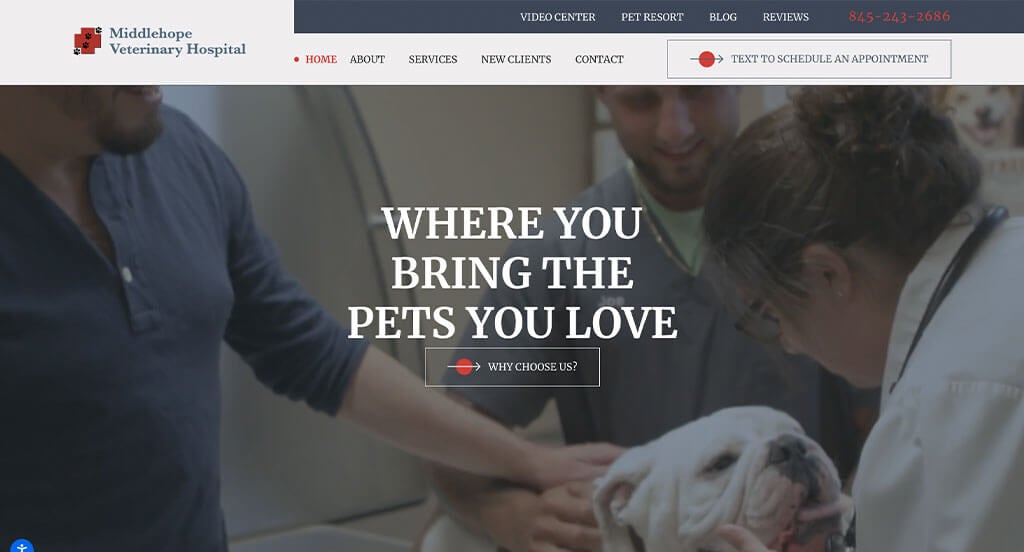
Showcasing a clean and intuitive layout, this site keeps things simple for a veterinarian website. The part of this website’s homepage that caught our attention was definitely their adorable paw print graphics displayed throughout the page. The color palette was a great choice for a unique website. Middlehope Veterinary Hospital clearly had a focus on website usability when designing the use of buttons throughout their website. Give some thought to the one-of-a-kind design of this veterinarian website when developing your next custom website.
2. River City Veterinary Hospital
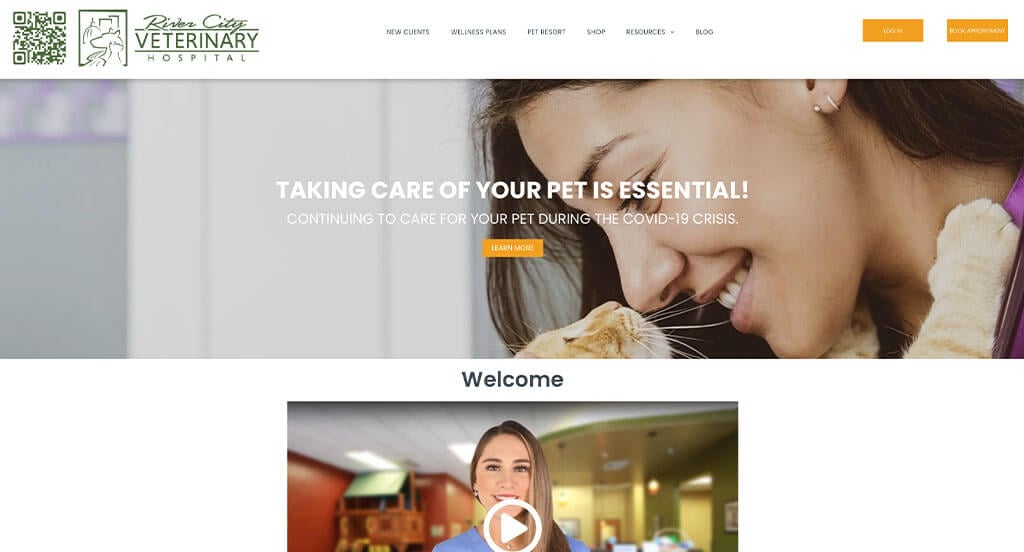
The black, white, orange, green and tan color palette seen in this veterinarian website stood out to us because it creates a healthy and youthful feel. Of all the veterinarian websites we reviewed, one of the features in this custom website we liked was their about us page. Their navigation bar with organized categories was refreshing for a custom veterinarian site. They clearly had a focus on website marketing when creating the creative logo design for their website. There was no shortage of reasons to include this website in our list of websites for veterinarians to consider when designing their next website.
3. BluePearl Pet Hospital
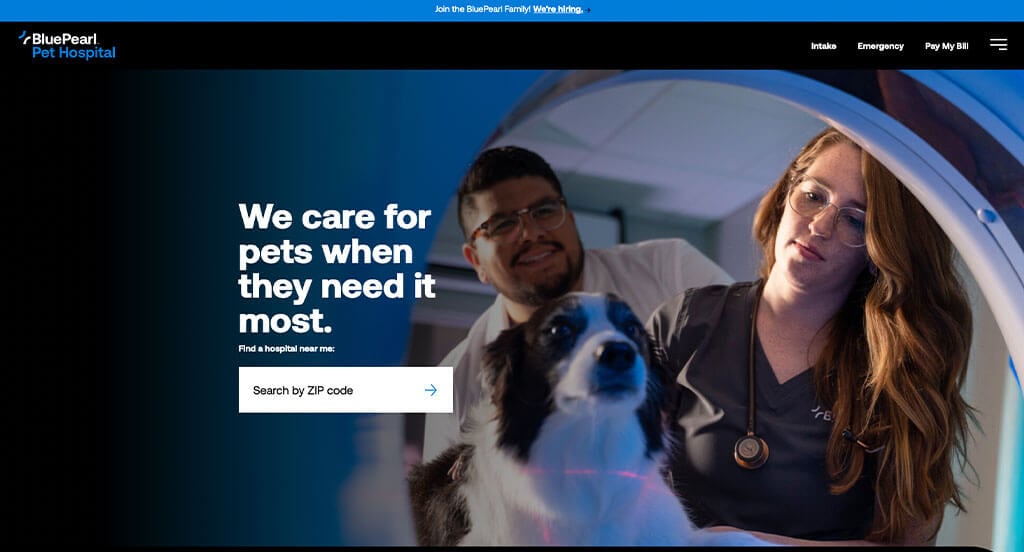
We liked how this veterinarian website combined the colors of blue, white and black into a custom web design layout. The most refreshing part of this veterinarian website was their imagery that complemented their color scheme. Another design quality in this creative veterinarian website was their alternating background color to break up their content. From a marketing perspective, we really liked the way they utilized an online payment page. For veterinarians looking for ideas on their next website, this example will definitely be one to consider.
4. Thrive Pet Healthcare
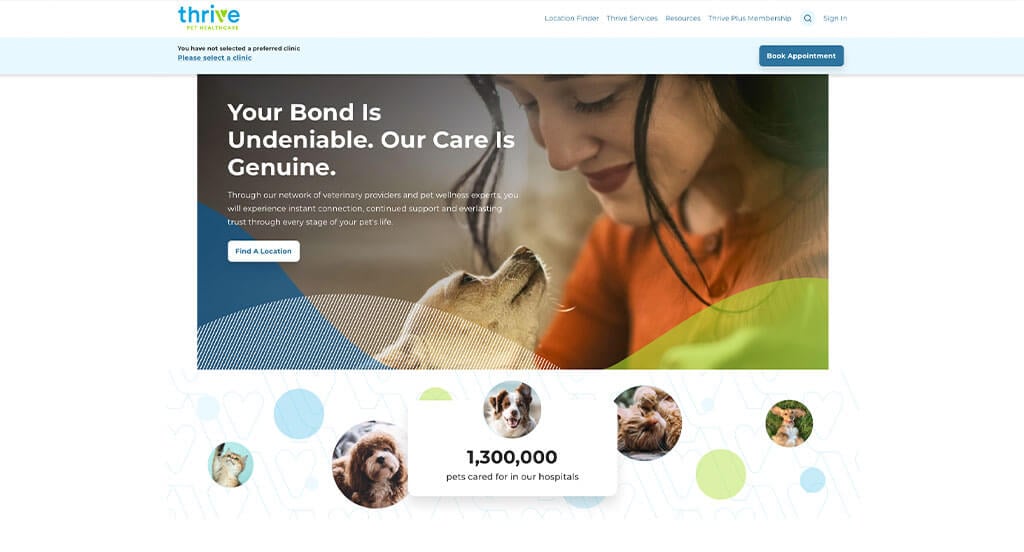
For a veterinarian website, they did a great job utilizing the white, green and blue colors throughout their site. After scrolling past the navigation of this veterinarian site, you’ll notice the playful feel to their pages. The addition of customer reviews was a nice touch for a veterinarian website. Thrive Pet Healthcare clearly had website marketing in mind with their use of graphics throughout their website. If you are looking for template examples for your next veterinarian site, give some thought to this one.
5. Adobe Veterinary Center
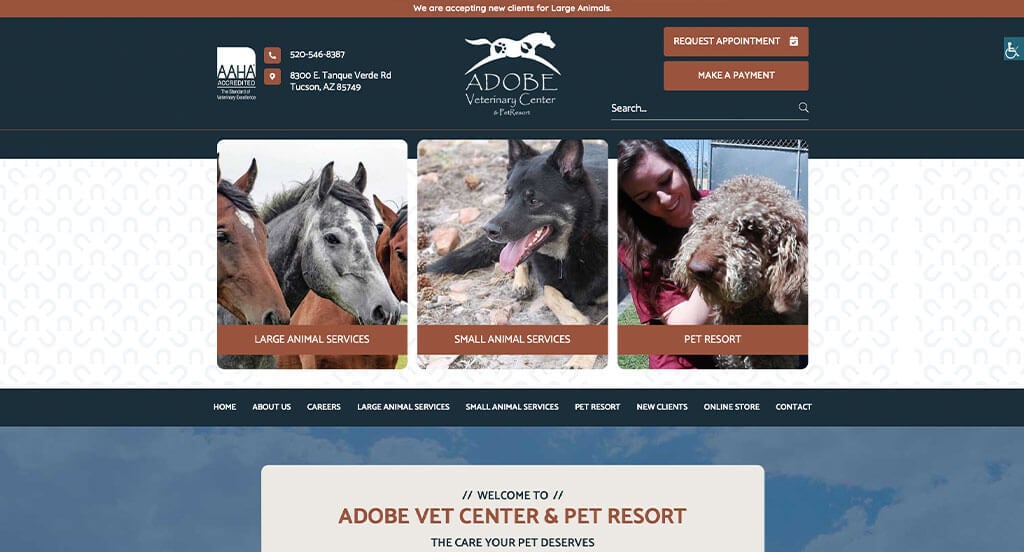
This is a good example of a website for veterinarians looking for custom web design layout ideas. One of the homepage features of Adobe Veterinary Center we noticed was their thoughtful logo design. Another design quality in this clean veterinarian site we liked was their use of professional text. The simple contact information was one of the marketing features that really stood out when reviewing this website. What a great website to review when designing your next website!
6. American Veterinary Medical Association
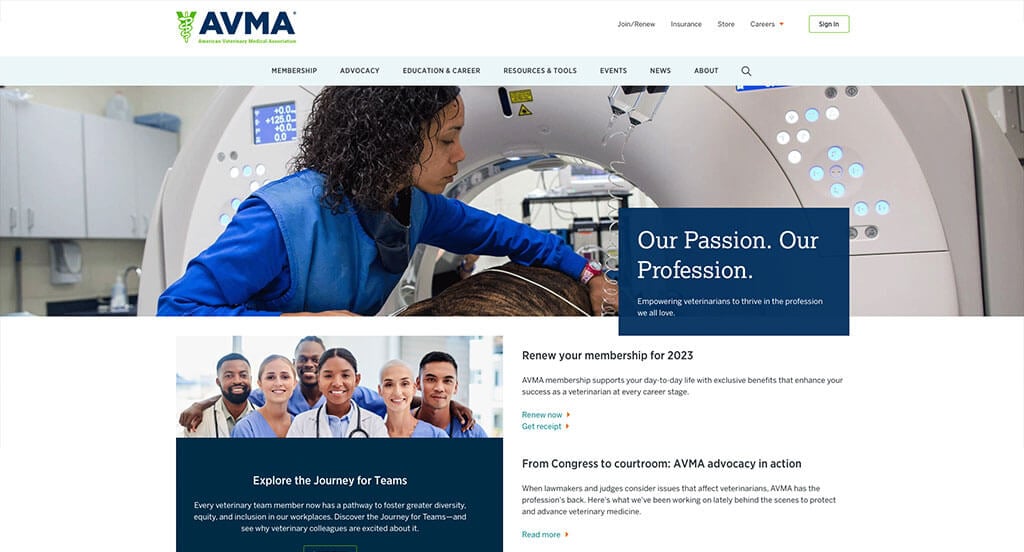
This is a great example for veterinarians looking for a professional look and feel for their next website. The layout of this veterinarian website was thoughtful because of their high-quality imagery. The addition of a blog was another unique quality in this professional veterinarian site we enjoyed. From a marketing point of view, we really liked the way they utilized buttons throughout their pages. Be sure to consider the one-of-a-kind design of this veterinarian website when developing your next custom website.
7. American Animal Hospital Association
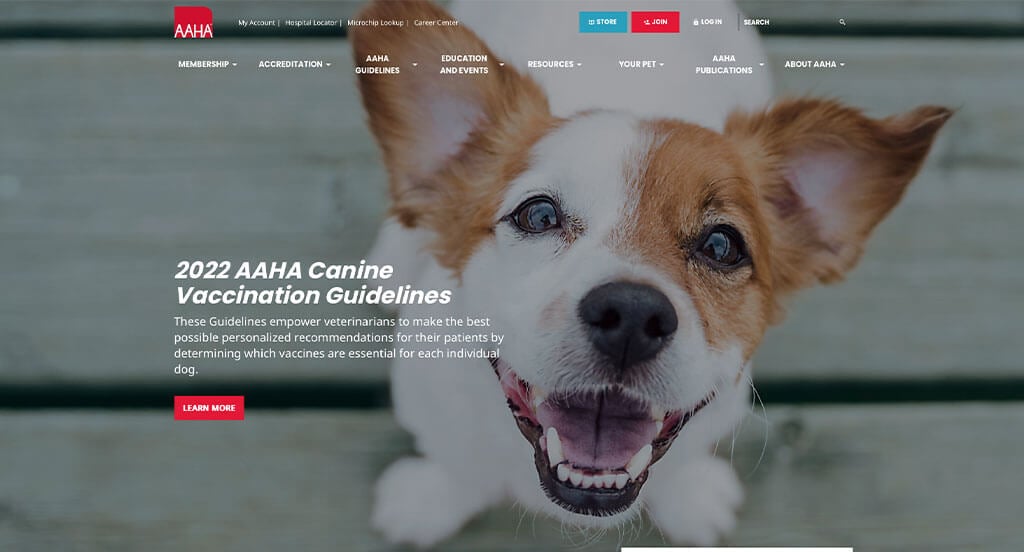
We chose American Animal Hospital Association because of its nicely organized veterinarian website that uses a blue, white and red color scheme. Of all the custom veterinarian websites we reviewed, one of the features in this custom website we liked was their large imagery. The navigation bar with organized categories was refreshing for a custom veterinarian website. They had digital marketing in mind when designing the color blocks to break up their content in their website. These were just a few of the numerous qualities in this website to consider when putting together this list of top websites for veterinarians.
8. PetPlace
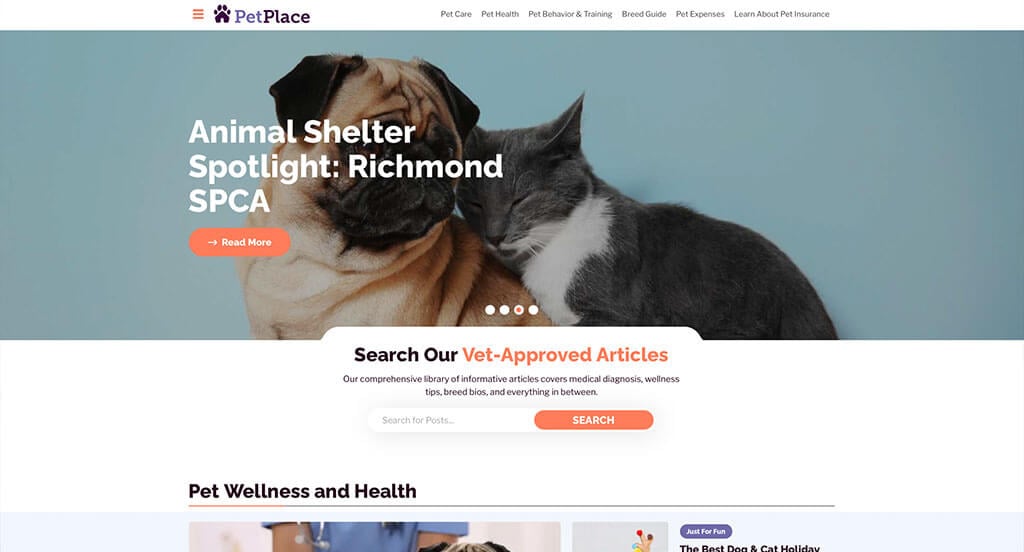
We liked how this veterinarian website combined a variety of colors into a custom web design. As you scroll through the homepage of the website, one of the qualities you’ll notice right away is the organized content. The color coded labels were a good choice for a professional site. PetPlace clearly had a focus on website accessibility when including videos into their website. Give some thought to the great design of this veterinarian website when building out your next website.
9. Pet Poison Helpline
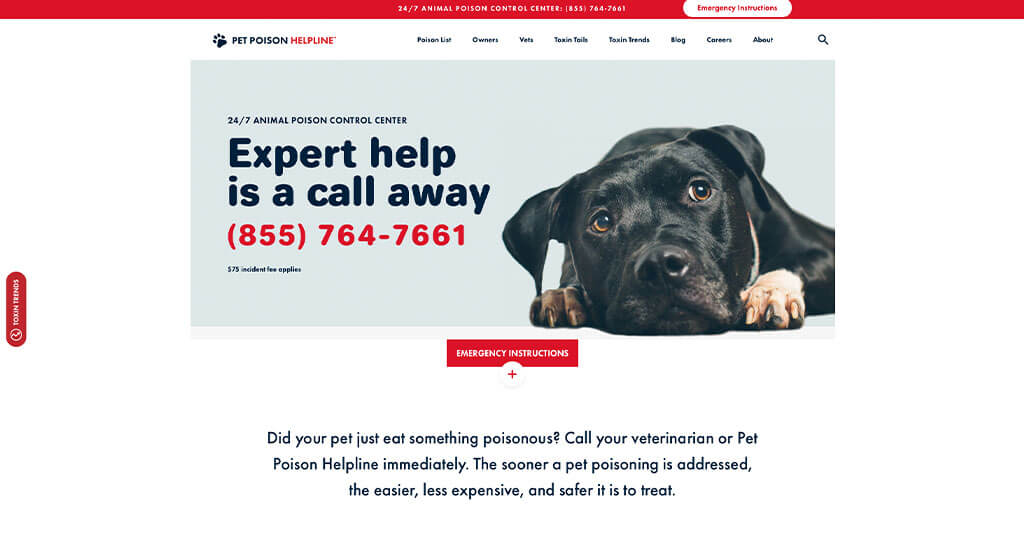
The red, dark blue and white color palette used in this custom veterinarian site stood out to us because it creates a simple but informational design. The use of statistics was likely the most impactful feature in the homepage of this website. Another thoughtful feature in this custom veterinarian site was the addition of a blog. From a marketing viewpoint, we really liked the way this veterinarian website utilized an easily accessed phone number. Any web designer developing websites for veterinarians will want to consider checking this website out.
10. Richland Animal Clinic
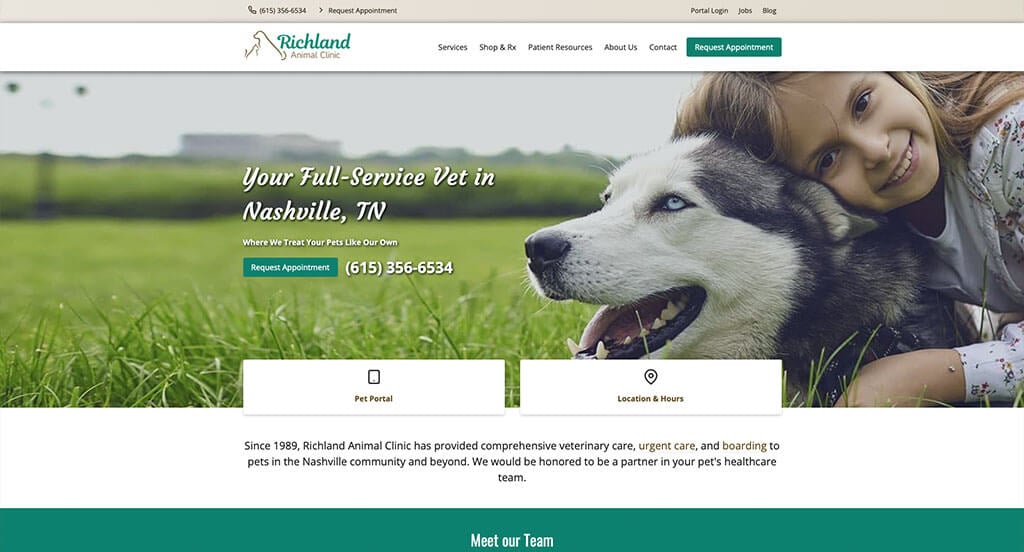
The Richland Animal Clinic website has a very professional feel to it, thanks to its unique use of white, brown, tan and turquoise. The most attention grabbing aspect in this veterinarian website was definitely their use of buttons for simple navigation throughout their site. Another thoughtful feature in this clean veterinarian website was their well labeled navigation bar. Richland Animal Clinic clearly had a focus on internet marketing when designing the domain for their website that matches the company’s name. Don’t skip past this website when hunting for design ideas for your next veterinarian website!
11. Lakefield Veterinary Group
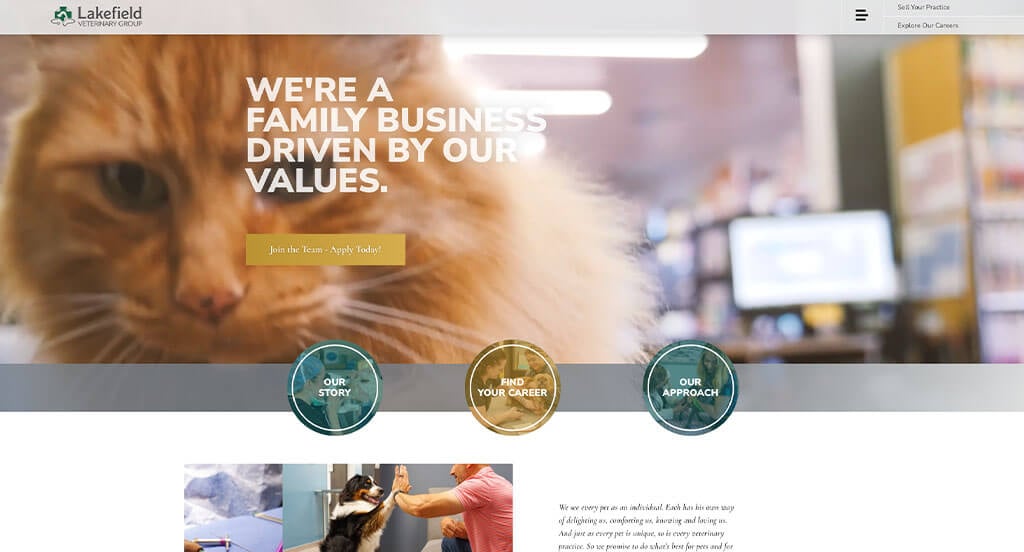
We immediately noticed the white, black and green color scheme used in the Lakefield Veterinary Group website, which we liked because of the subtle green accent that didn’t overpower the page. The layout that spread out the text and imagery was definitely the most impactful feature in the homepage of Lakefield Veterinary Group. Another design quality in this professional veterinarian website we liked was their thought provoking logo design. Their clearly labeled menu helped make this one of the top veterinarian websites we reviewed. For veterinarians looking for examples for their next website layout, this design example will absolutely be one to consider.
12. Animal Hospital of Old Saybrook
Related: Invigorate your veterinary clinic with a digital advertising service that incorporates lead generation, social media marketing, and online reputation management.
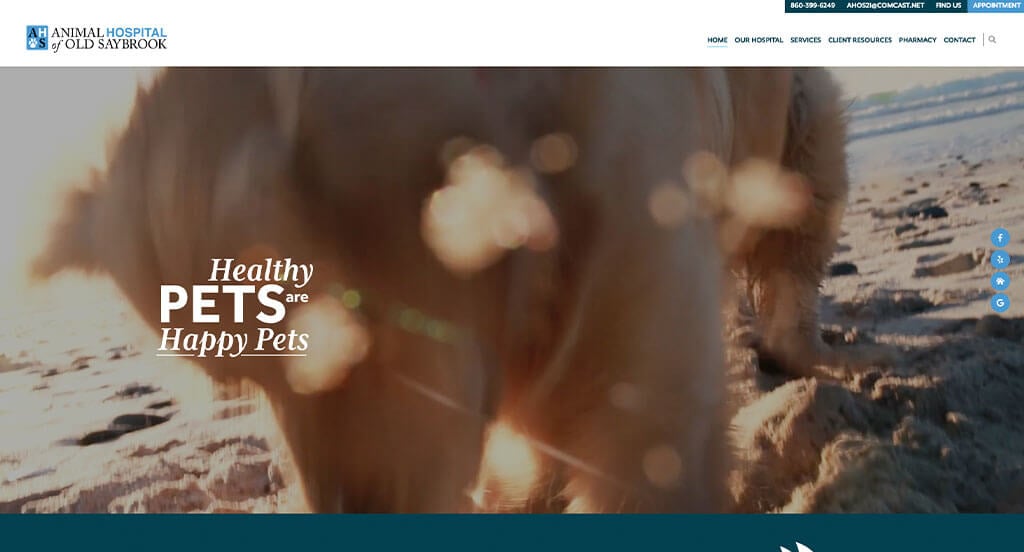
This is a good example of a website design for veterinarians to check out when looking for a professional website idea. Our web designers thought this was a good example of a homepage layout for veterinarians because of their calming color scheme. The professional font was definitely refreshing for a custom veterinarian website. They clearly had website marketing in mind when creating the addition of a map. Be sure to consider the one-of-a-kind design of this veterinarian website when developing your next custom website.
13. Animal Hospital of Parkland
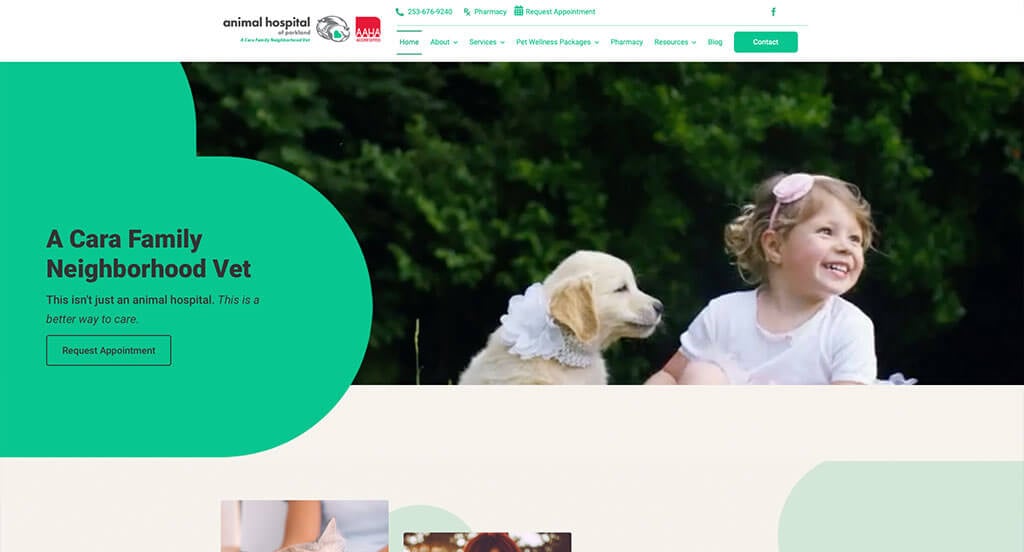
The white, teal and tan colors used in this custom veterinarian website stood out to us because it’s vibrant but doesn’t distract from the page. One of the design features we liked most on the homepage of Animal Hospital of Parkland was their subtle animations because that isn’t something you find on most veterinarian websites. Another thoughtful quality in this professional veterinarian site was their unique layout for their imagery. Animal Hospital of Parkland had ease of use in mind when creating the well organized navigation bar for their website. So many attractive qualities in this website to consider.
14. Cincinnati Family Vet

This is a great website design idea for a veterinarian looking for custom website layout ideas. The adorable logo design was probably the most impactful feature in the homepage of this website. Another thoughtful feature in this professional veterinarian site was their use of different graphics throughout the pages. Cincinnati Family Vet clearly had conversions in mind when creating the domain for their website that matches their company’s name. Don’t scroll past this website when hunting for design ideas for your next veterinarian website!
15. Chimacum Valley Veterinary Hospital
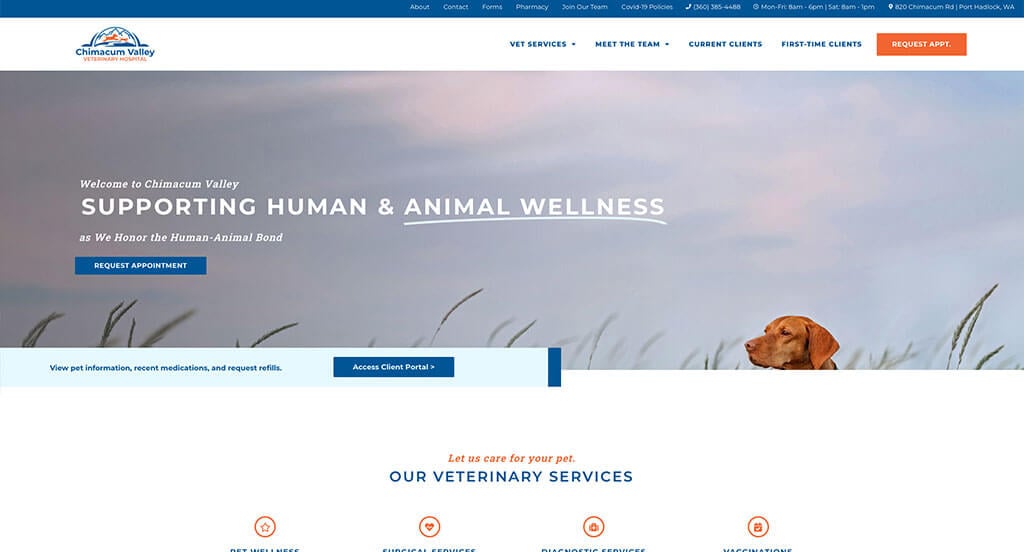
This is a great website example for veterinarians who are looking for a custom site layout. The part of this website’s homepage that caught our attention was definitely the template with a good balance of white space. Another thoughtful quality in this custom veterinarian site was their simple navigation. They clearly had a focus on internet marketing when building the testimonial section for their website. If you are looking for template ideas for your next veterinarian site, be sure to check this one out.
16. Gallant Vet Hospital
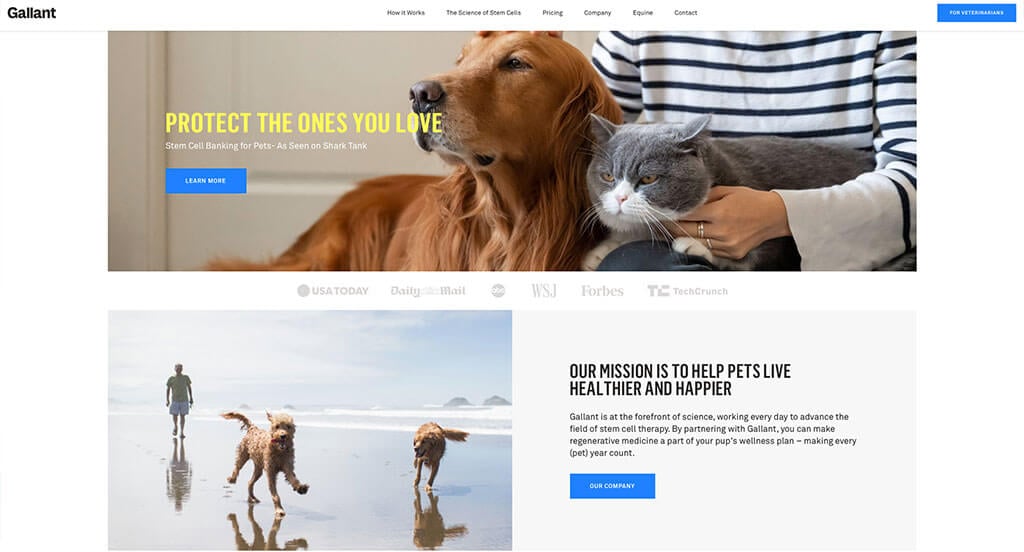
Showcasing a clean and intuitive layout, this website keeps things simple for a veterinarian site. The use of graphics or icons in their design was definitely the most impactful feature in the homepage of Gallant Vet Hospital. The use of buttons throughout their site was refreshing for a custom website. Gallant Vet Hospital clearly had ease of use in mind when building the well-labeled navigation bar for their website. Give some thought to the creative design of this veterinarian website when developing your next custom website.
17. Bond Vet
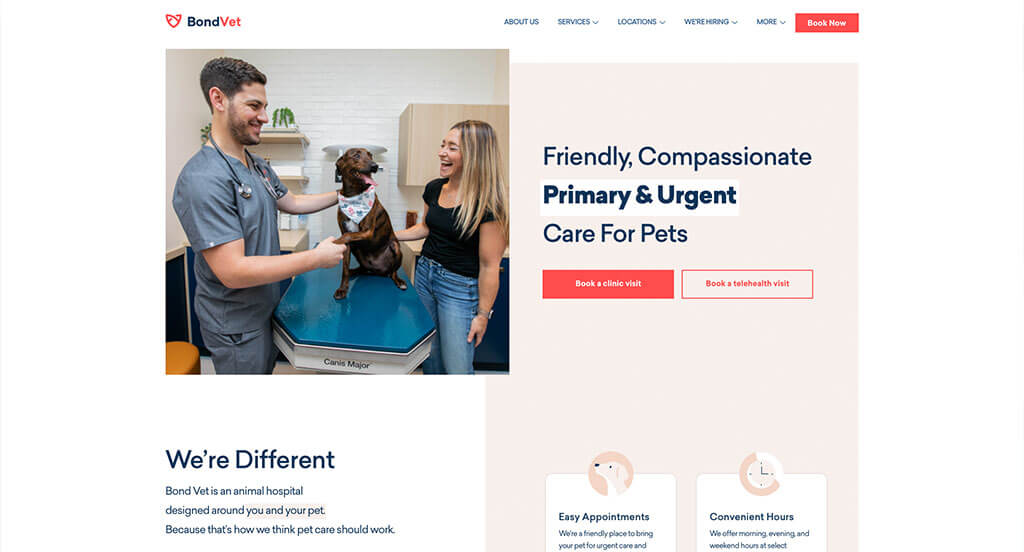
This is a good example of a veterinarian website design for someone searching for a professional website design idea. After scrolling past the navigation of this veterinarian website, you’ll notice their interesting logo design. Their thoughtful template was a unique choice for a custom site. They had digital marketing in mind when creating the graphics spread throughout their website. What a great website to review when building out your next website!
18. Guelph Cat Clinic
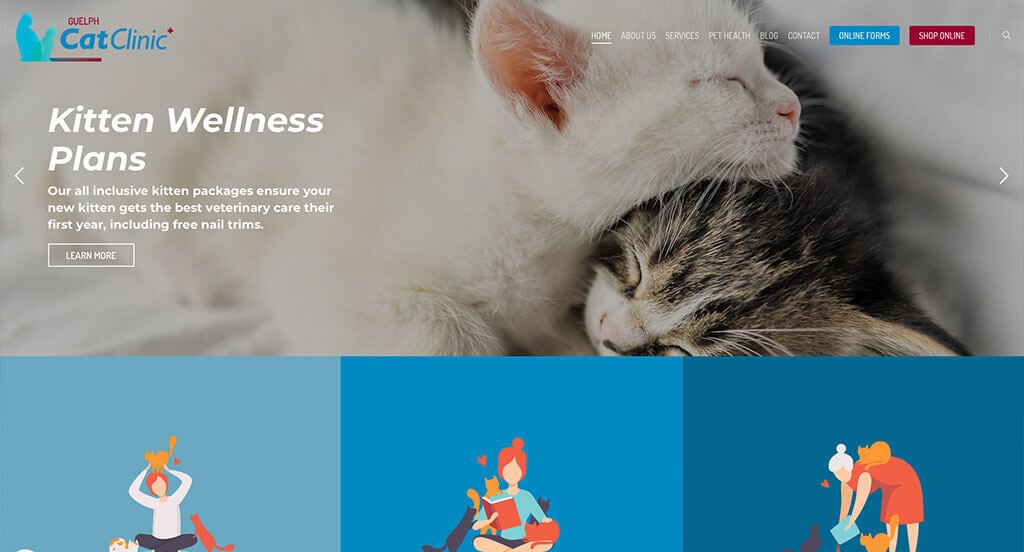
Guelph Cat Clinic has a great veterinarian website that uses blue, white and black for a color scheme. After scrolling past the navigation of this veterinarian site, you’ll notice their variety of fonts. The navigation bar with organized categories was refreshing for a professional site. The simple contact information helped make this one of the best veterinarian websites we looked at. With so many quality reasons to consider this veterinarian website, it’s obvious why we included it in this list of the best sites!
19. Paz Veterinary

We chose Paz Veterinary because of its nicely organized veterinarian website that uses a variety of colors for their color scheme. After scrolling past the header of this veterinarian website, you’ll immediately notice the interesting graphics. The subtle animations were definitely refreshing for a professional veterinarian website. The customer reviews helped make this one of the top veterinarian websites we reviewed. For the veterinarians out there checking website examples, make sure to check this one out!
20. VETgirl
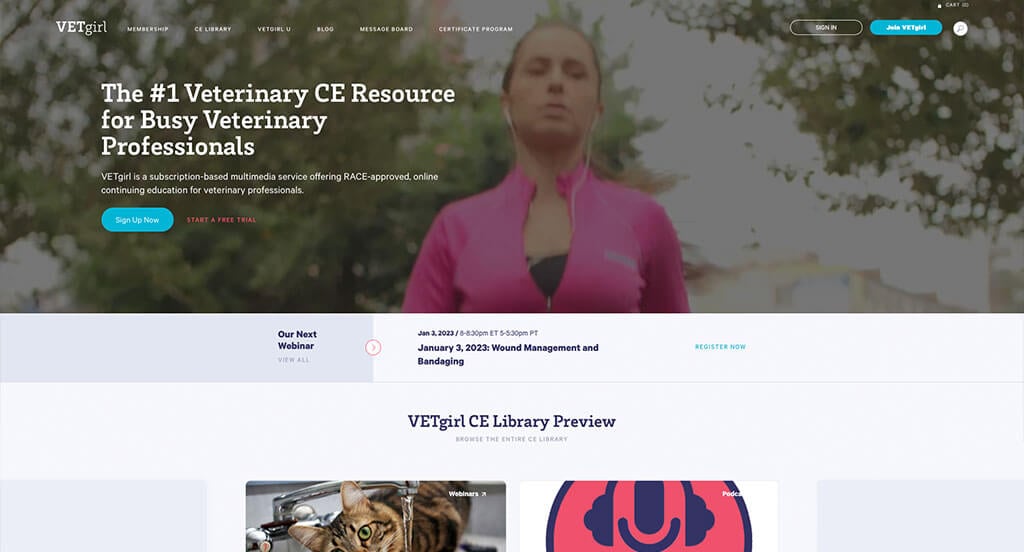
This is a good example of a website design for veterinarians looking for a professional look and feel for their next website. After scrolling past the header of this veterinarian website, you’ll immediately notice the display of their blog articles. The captivating font was refreshing for a professional website. They clearly had a focus on website accessibility when designing the clearly labeled menu for their website. Be sure to consider the creative design of this veterinarian website when developing your next custom website.
21. SHH Vet Center
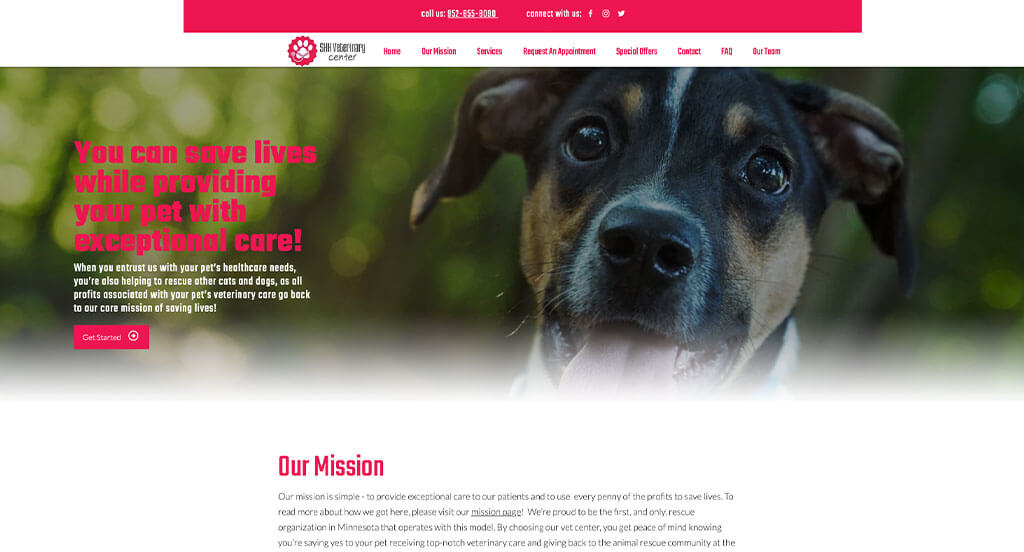
The website of SHH Vet Center ranked because it’s one of the nicer veterinarian websites we reviewed. The high-quality visuals were definitely the most impactful quality in the homepage of SHH Vet Center. The organization of their content was another thoughtful feature in this professional veterinarian website we enjoyed. They clearly had website usability in mind when building the domain for their website that matches their company’s name. Don’t scroll past this website when hunting for design ideas for your next veterinarian website!
22. Somers Animal Hospital
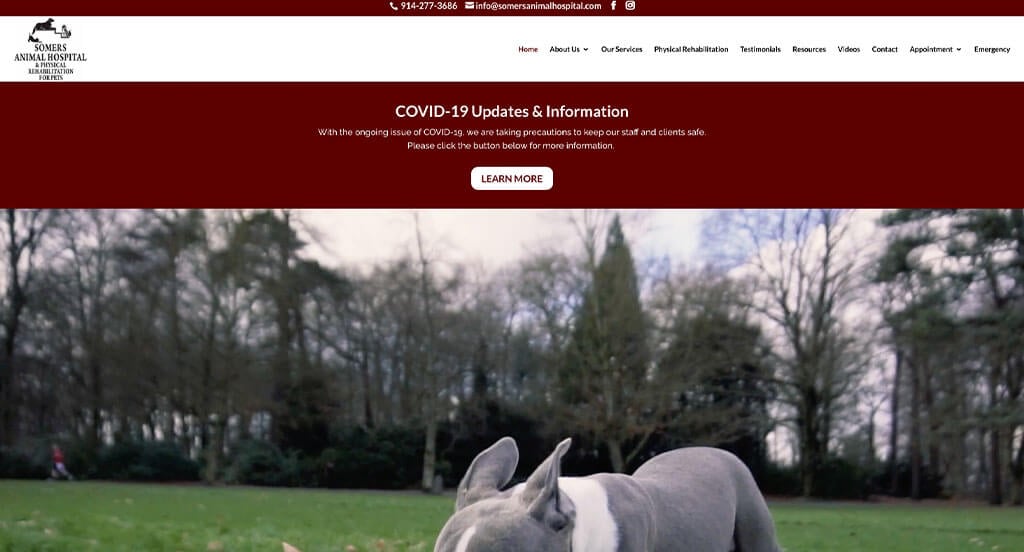
This is a good example of a website for a veterinarian to check out when looking at custom web design layout ideas. After scrolling past the header of this veterinarian site, you’ll notice their relaxing color palette. Their client review section was refreshing for a unique veterinarian website. Somers Animal Hospital had digital marketing in mind when creating the simple contact information for their website. Give some thought to the great design of this veterinarian website when developing your next website.
23. CountrySide Veterinary Clinic
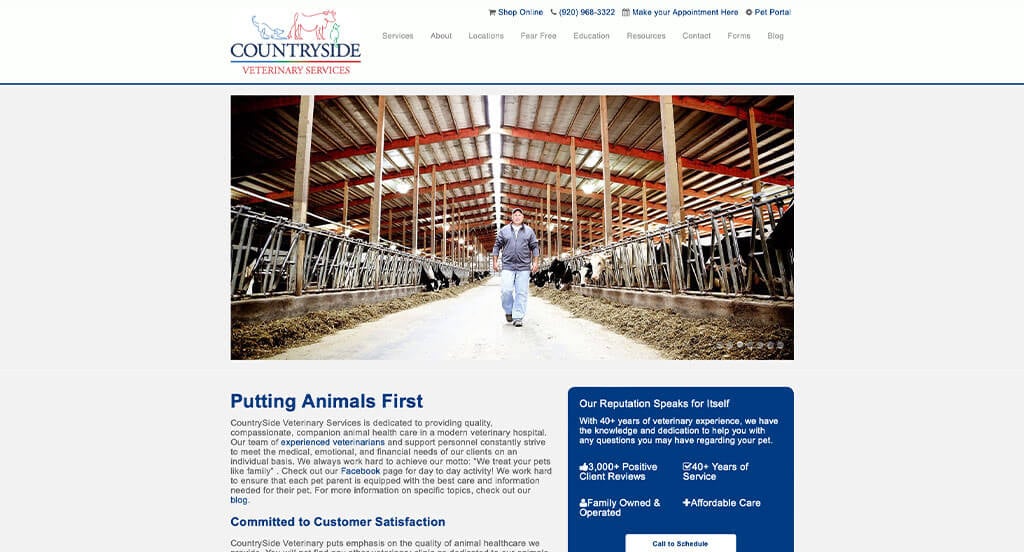
There were a lot of veterinarian sites to choose from, but the website of CountrySide Veterinary Clinic was a great example of a nicely organized website with a variety of colors for their color scheme. The creative logo design was definitely the most impactful feature in the homepage of CountrySide Veterinary Clinic. Another thoughtful quality in this clean veterinarian website was their layout that was free of distractions. CountrySide Veterinary Clinic clearly had website accessibility in mind when designing the simple buttons to call or make an appointment through their website. Don’t skip past this website when hunting for design ideas for your next veterinarian website!
24. Wellness Veterinary Clinic
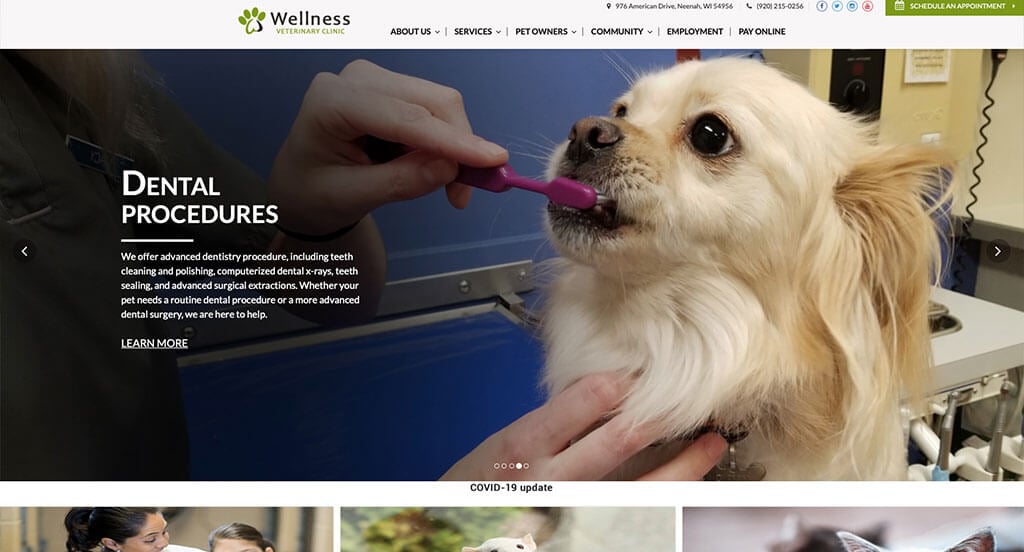
We chose Wellness Veterinary Clinic because of its nicely organized website that uses a white, green and gray color scheme, which we like because it reminds viewers of health and wellness. The use of animals throughout their page was definitely the most impactful feature in the homepage of Wellness Veterinary Clinic. Another thoughtful quality in this custom veterinarian site was their navigation bar with organized categories. From a marketing perspective, for a veterinarian website we liked the way they utilized icons as buttons for simple navigation. You won’t be disappointed after reviewing this website for design ideas for your next website!
Related: Looking to fill open availability of your veterinarians? A local SEO service can help improve your organic traffic and get the phones ringing!
25. Animal Medical Center of Appleton
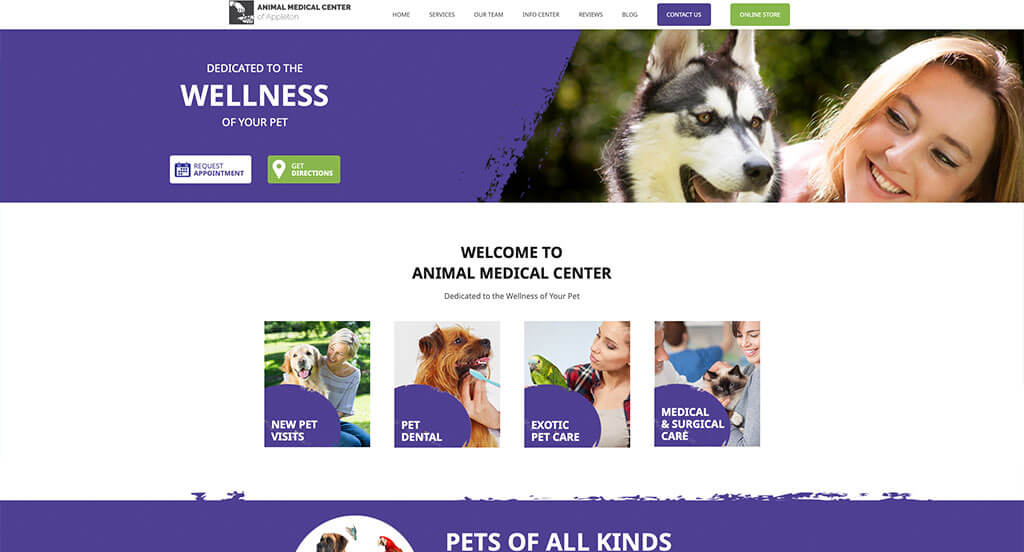
This is a good example of a veterinarian website design for someone looking for professional layout ideas. After scrolling past the navigation of this veterinarian site, you’ll immediately notice their creative color palette. The addition of a blog was a great choice for a unique veterinarian site. They clearly had website accessibility in mind when building the well-labeled navigation bar for their website. Any website designer building websites for veterinarians will want to consider checking this website out.
26. Appanasha Pet Clinic
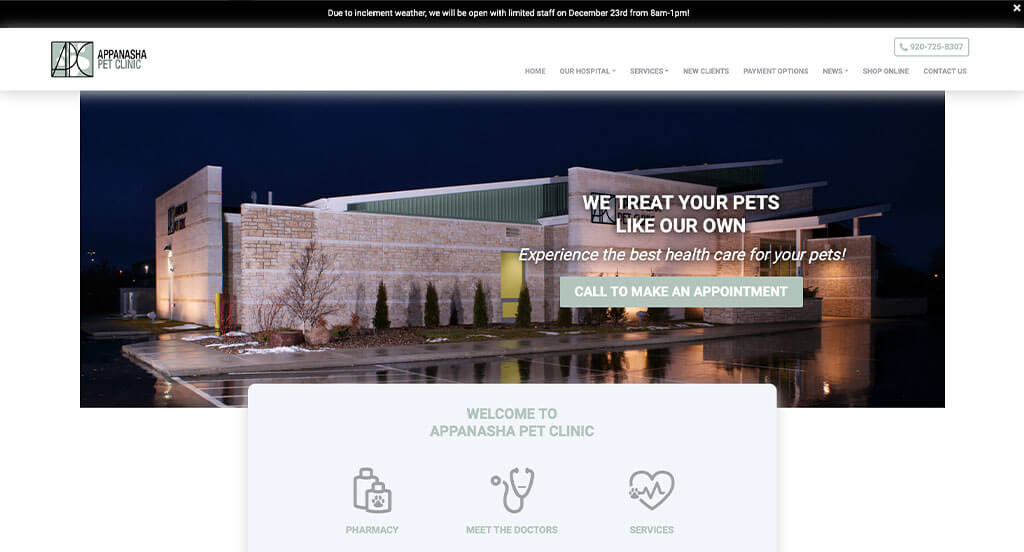
Appanasha Pet Clinic has a well-designed veterinarian website that uses white, light green and black for a color palette. The display of their operating hours was likely the most impactful feature we noticed in the homepage of this website. Another feature in this professional veterinarian website we enjoyed was the layout that was easy to follow. The domain for their website that matches the company’s name was a marketing feature we noticed right away. If you are looking for template options for your next veterinarian site, give some thought to this one.
27. Country View Animal Hospital
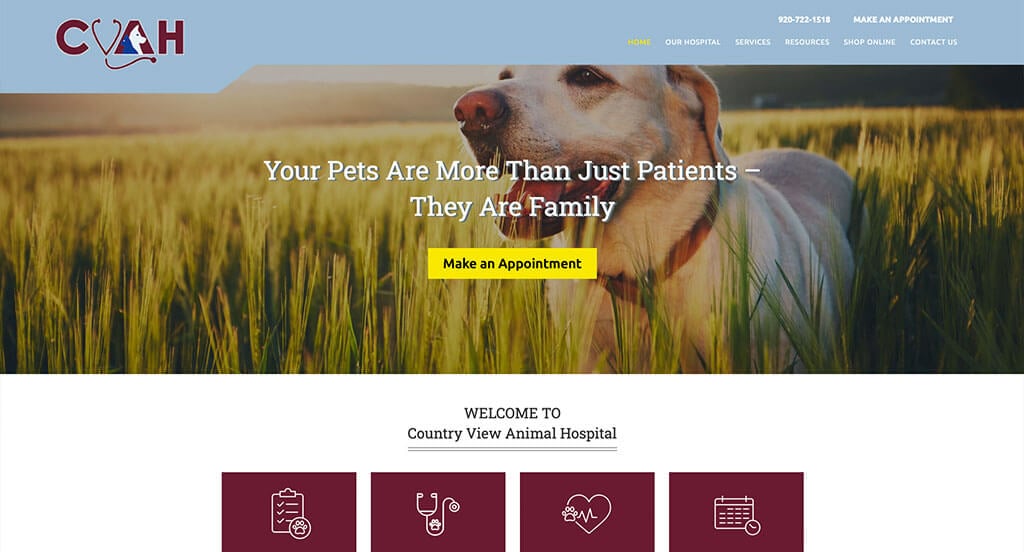
Country View Animal Hospital has a well-designed veterinarian website that uses a blue, maroon, white and yellow color palette. We thought this was a good homepage design example for veterinarians because of their thought provoking logo design. Another thoughtful quality in this professional veterinarian website we noticed was the navigation bar with organized categories. Country View Animal Hospital had website usability in mind when designing the buttons for simple navigation throughout their website. Be sure to consider the one-of-a-kind design of this veterinarian website when building your next website.
28. Burr Ridge Veterinary Clinic
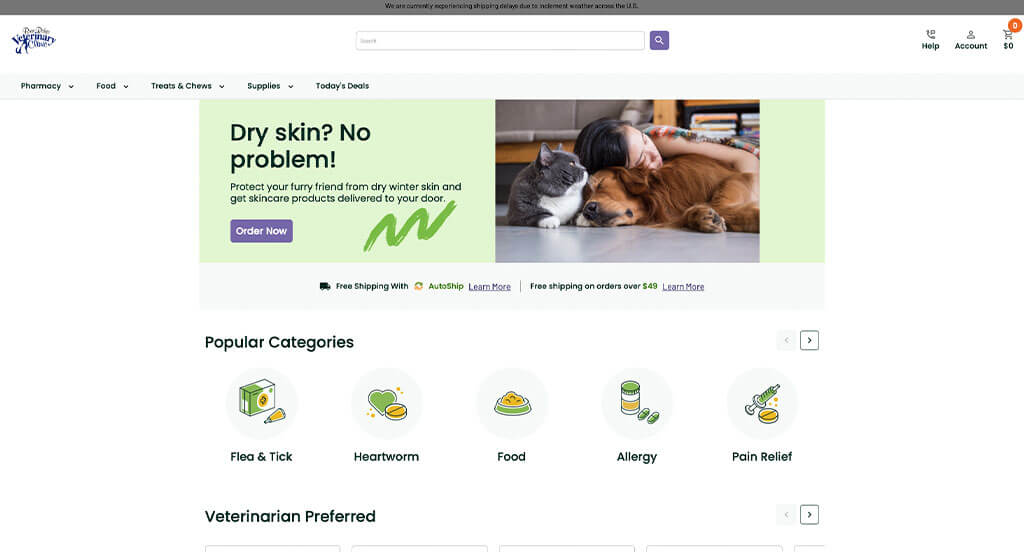
This is a good example of a veterinarian website design that can provide inspiration for a new professional website. As you scroll through the homepage of this website, one of the qualities you’ll notice right away is their creative accent colors. Another thoughtful feature in this clean veterinarian site we liked was their use of a variety of graphics. Burr Ridge Veterinary Clinic had internet marketing in mind when building the search bar for their website. For veterinarians looking for ideas on their next website, this example will definitely be one to keep in your back pocket.
29. Fishtown Animal Hospital
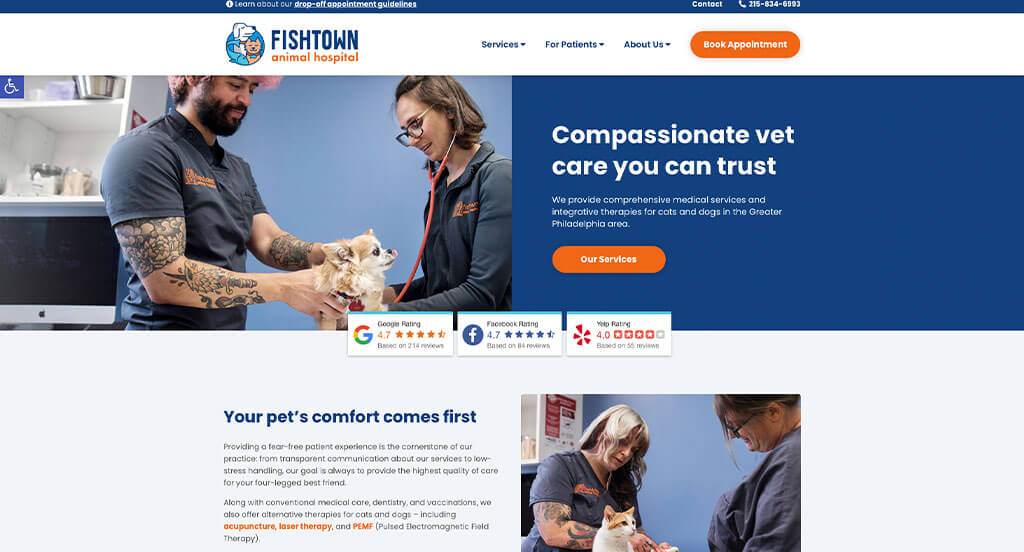
We chose Fishtown Animal Hospital because of its nicely organized veterinarian website that uses a blue, orange and white color scheme. After scrolling past the navigation of this veterinarian site, you’ll notice their use of graphics. Another design quality in this custom veterinarian website we enjoyed was their incorporation of social media. They clearly had conversions in mind when creating the layout that feels authentic to their brand. Give some thought to the great design of this veterinarian website when building your next website.
30. Valley Pet Care
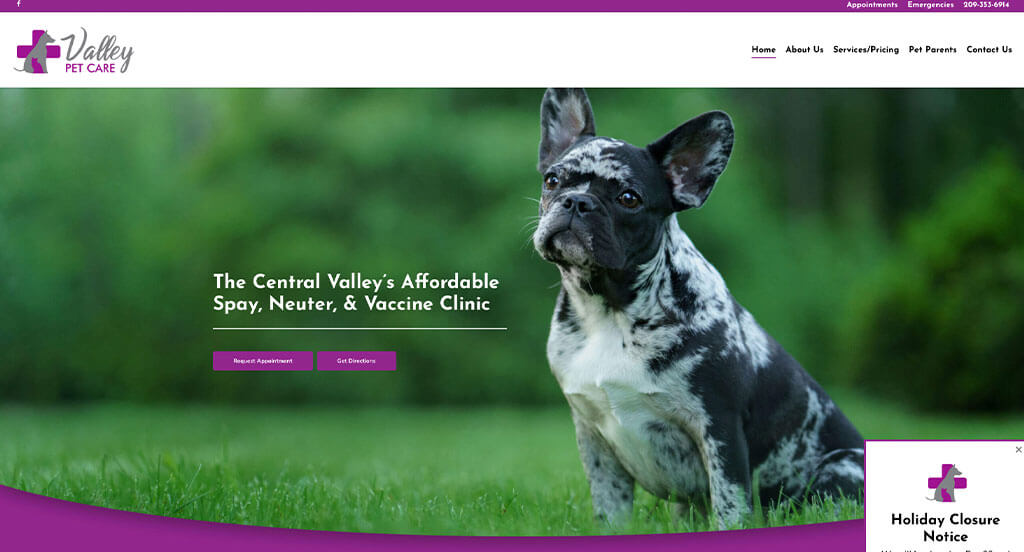
The gray, purple, white and black color palette used in this veterinarian site stood out to us because it feels energetic. The frequently asked questions section was probably the most impactful quality in the homepage of this website. The navigation bar with more precise categories was definitely refreshing for a unique veterinarian site. Valley Pet Care clearly had a focus on website accessibility when designing the domain for their website that matches the company’s name. What a great website to review when designing your next veterinarian website!
31. Healing Hands
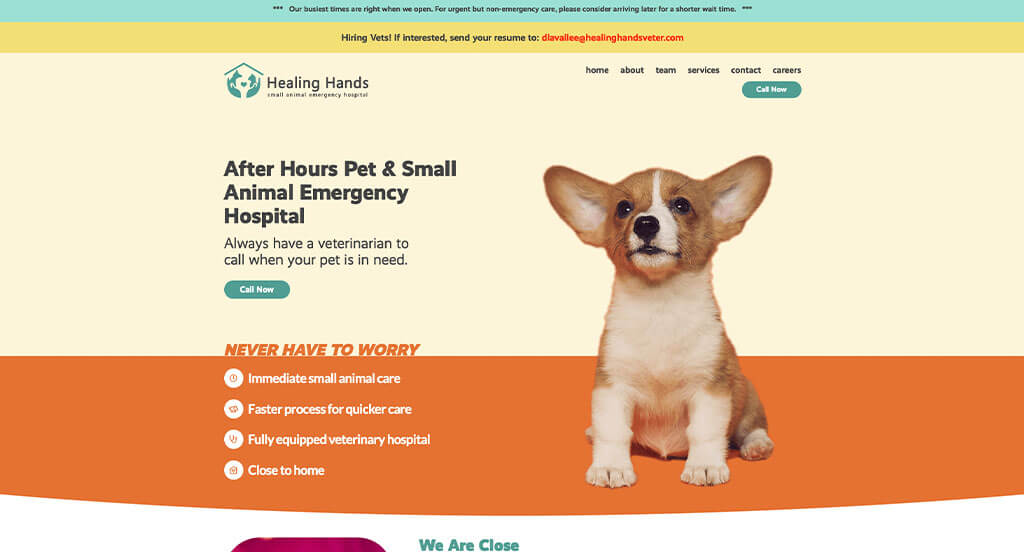
This is a good website example of a website design for veterinarians who are looking for a custom look and feel for their next site. One of the design features we liked most on the homepage of Healing Hands was their creative logo design. The high-quality visuals were a nice touch for a professional site. They had website usability in mind when designing the clearly labeled menu for their website. With so many quality reasons to consider this veterinarian website, it’s no wonder we included it in this list of the best sites!
32. Crossroads Animal Clinic
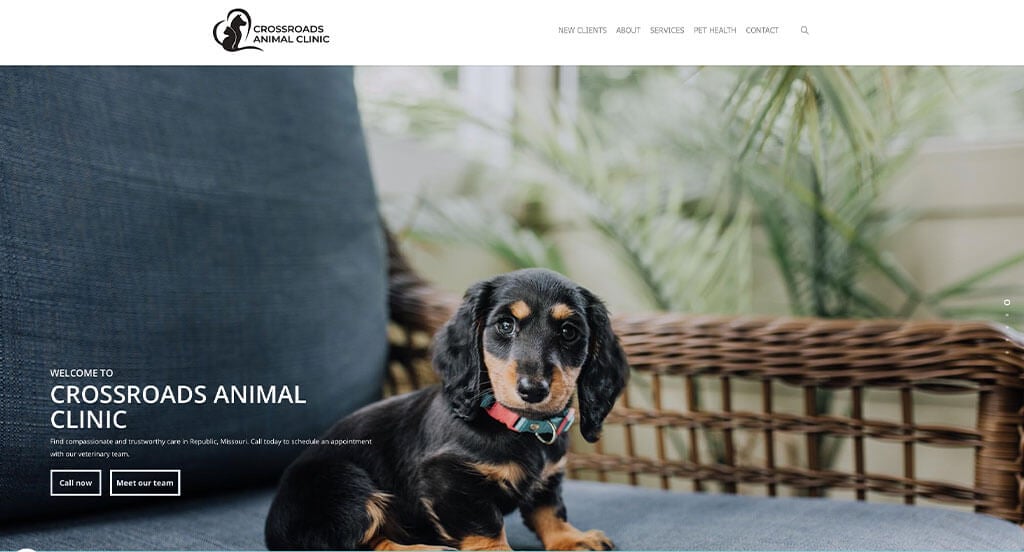
The website of Crossroads Animal Clinic ranked because it’s one of the better looking veterinarian websites we came across. The most attention grabbing aspect of this veterinarian website was definitely the smooth transitions. This custom veterinarian site also does a good job with their use of icons. They clearly had a focus on website marketing when designing the organized layout for their website. Don’t skip past this website when hunting for design ideas for your next veterinarian website!
33. Doorstep DVM
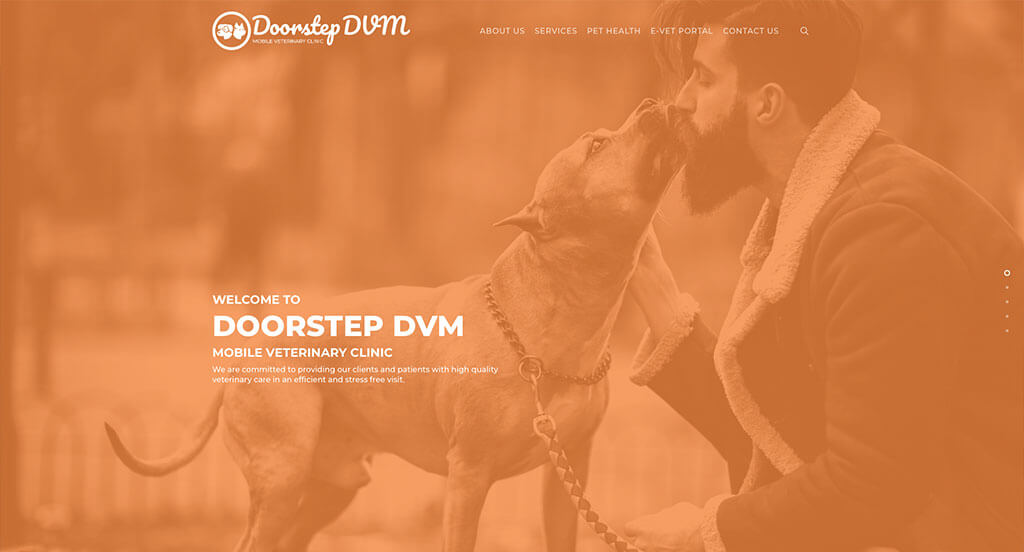
This is a great veterinarian web design example for someone who is looking to develop a professional website. One of the homepage features in Doorstep DVM we noticed was their use of images for their backgrounds because that isn’t something you find on most veterinarian websites. The stunning color palette was another thoughtful feature in this custom veterinarian website we enjoyed. From a marketing perspective, we liked the way this veterinarian website utilized simple navigation throughout the site. If you are looking for template options for your next veterinarian site, give some thought to this one.
34. Spanish Trail Veterinary Hospital

This is a great website design example for a veterinarian who is looking to pull inspiration for their next custom website. As you scroll through the homepage, one of the design qualities we liked was their high-quality imagery. The clearly labeled menu was a nice touch for a professional website. They clearly had internet marketing in mind when creating the use of buttons to enhance usability throughout their website. Talk about a great website to have included in this list of top websites!
35. Healthy Paws Forward Veterinary Hospital
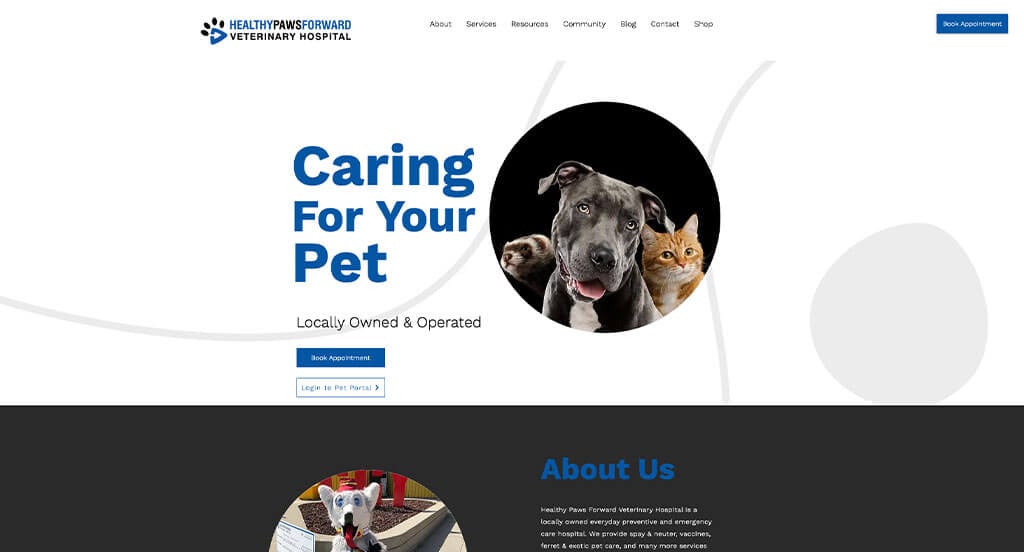
The green, black and white color scheme seen in this veterinarian website stood out to us because people associate green with health. After scrolling past the header of this veterinarian site, you’ll notice how they reuse their logo design throughout the site. This custom veterinarian website also does a good job with their optimized content. They clearly had a focus on conversions when designing the large button to book an appointment. Be sure to consider the great design of this veterinarian website when developing your next custom website.
36. Erie Animal Hospital
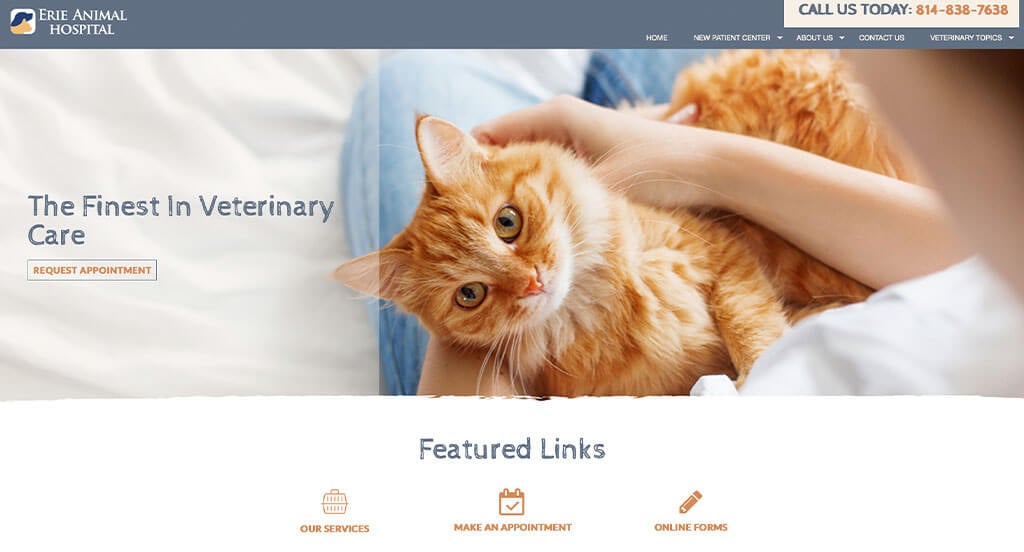
This is a good example of a veterinarian website design for someone who is searching for a professional website design idea. After scrolling past the navigation of this veterinarian website, you’ll immediately notice their automatically playing video. The creative font choice was one of the reasons we included this site in our rankings for the top website layout ideas for veterinarian sites. The relaxing color palette was one of the marketing features that really stood out when reviewing this website. Give some thought to the creative design of this veterinarian website when developing your next custom website.
37. Small Door Veterinary
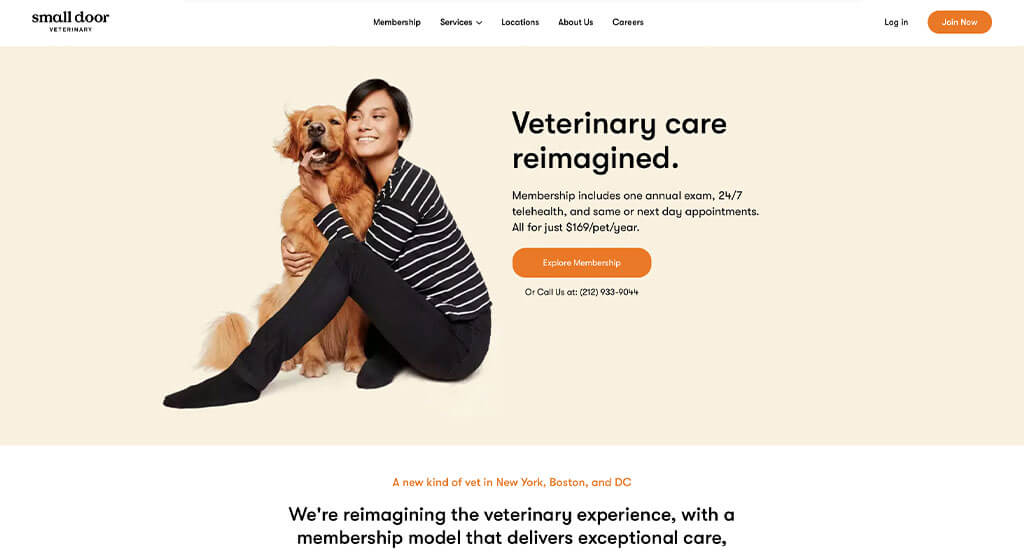
This is a great website design idea for a veterinarian looking for inspiration for their next custom websites. Our web designers thought this was a good example of a homepage layout for veterinarian because of the large font to emphasize their titles. Another feature in this clean veterinarian website was their unique color scheme. They clearly had website marketing in mind when creating the layout that was free of distractions for their website. Don’t scroll past this website when considering design ideas for your next veterinarian website!
38. Clearlake Veterinary Clinic
Related: Targeted paid advertising on search engines and social media can help generate leads for your veterinary practice.
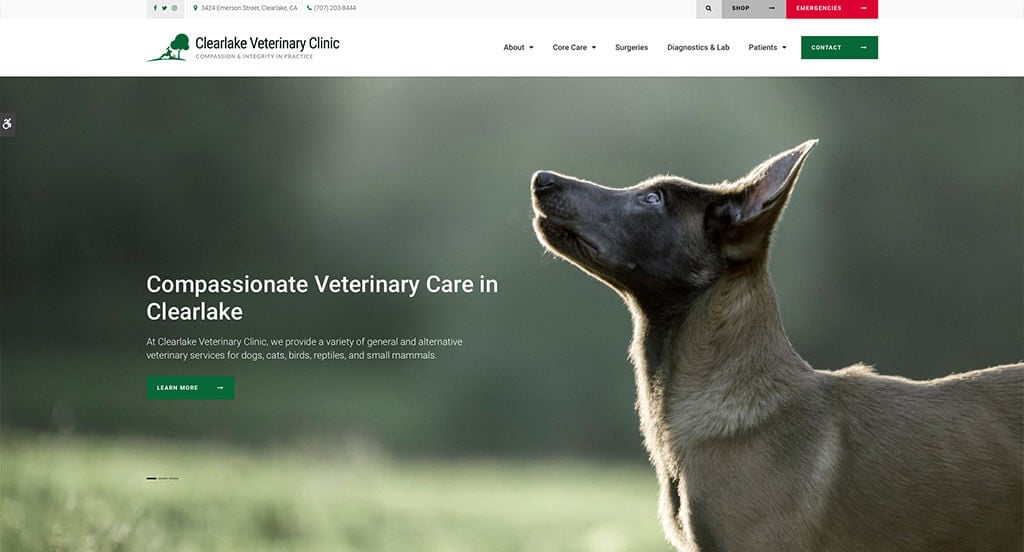
Clearlake Veterinary Clinic has a great veterinarian website that uses white, green and gray for a color scheme, which we like because it looks professional. Of all the veterinarian websites we reviewed, one of the features in this custom website we liked was the simple navigation. Another thoughtful feature in this clean veterinarian site was the layout with a good balance of white space. They clearly had ease of use in mind when designing the well-labeled navigation bar for their website. For veterinarian looking for examples for their next website layout, this design example will absolutely be one to keep in mind.
39. AZPetVet
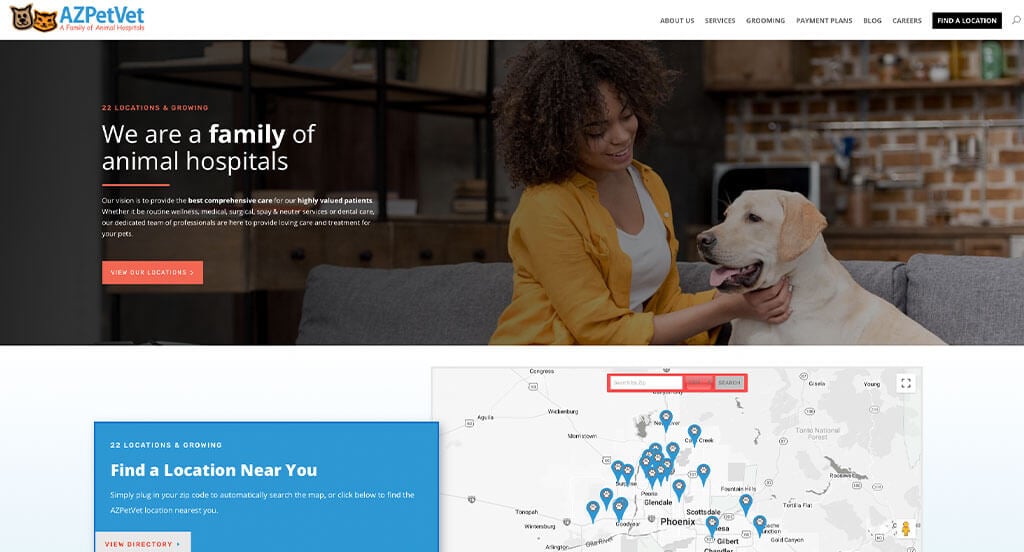
This is a good example of a website layout for a veterinarian looking for inspiration for their next custom web design. The stunning layout was definitely the most impactful feature in the homepage of AZPetVet. The incorporation of social media was refreshing for a unique veterinarian website. They clearly had conversions in mind when creating the use of a search bar for their website. What a great website to review when building out your next veterinarian website!
40. Sunburst Animal Hospital
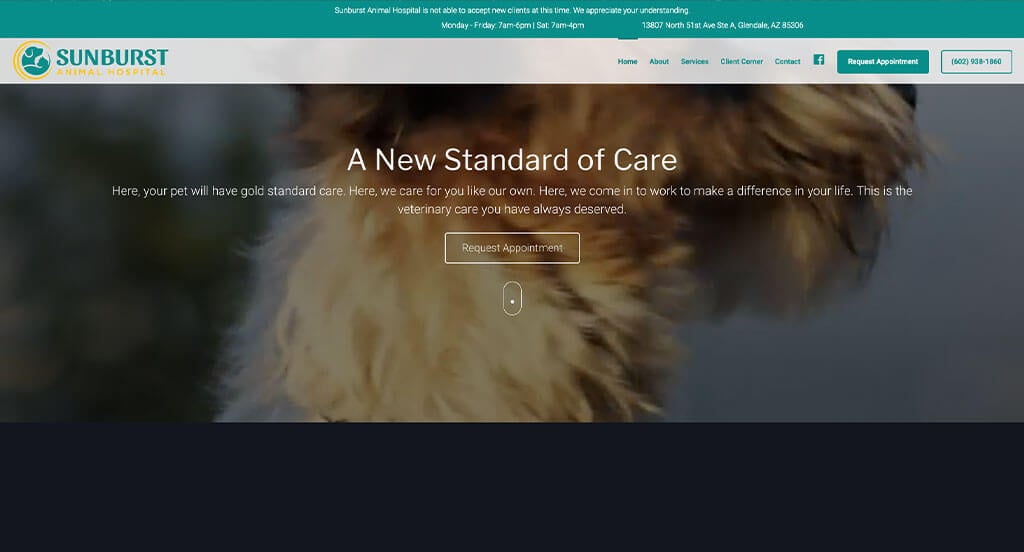
This is a good example of a veterinarian website design to check out when looking for a professional website layout idea. The unique logo design was likely the most impactful feature in the homepage of Sunburst Animal Hospital. The smooth transitions were refreshing for a professional veterinarian website. Sunburst Animal Hospital had website marketing in mind when creating the well-labeled navigation bar for their website. Don’t scroll past this website when hunting for design ideas for your next veterinarian website!
41. Arizona Humane Society
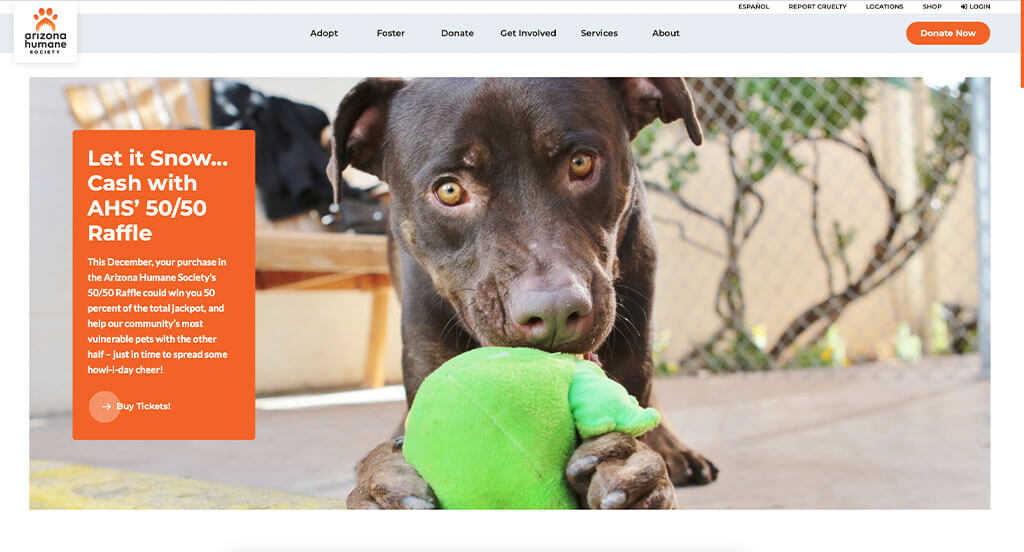
This is a great web design example for veterinarians who are looking for a professional layout. The part of this website’s homepage that caught our attention was definitely their playful and colorful graphics. Their statistics placed throughout the page was another feature in this custom veterinarian website we enjoyed. They clearly had a focus on website accessibility when creating the layout that was easy to navigate. With so many good reasons to consider this veterinarian website, it’s obvious why we included it in this list of the best websites!
42. Five Valleys Vet
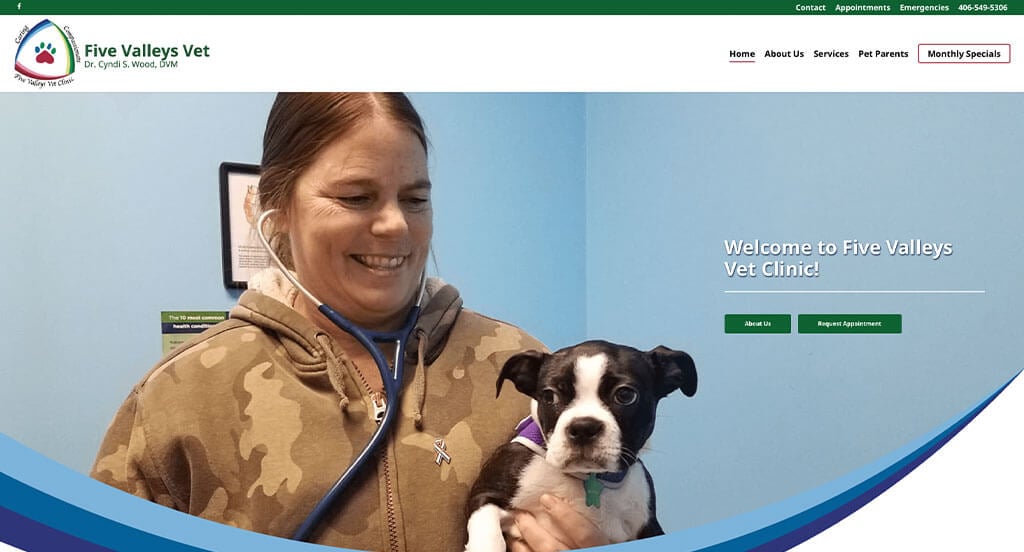
This is a good example of a website design for veterinarians who are looking for a custom site design. The colorful logo design was probably the most impactful feature in the homepage of Five Valleys Vet. Another thoughtful quality in this professional veterinarian site was their navigation bar with individual categories. They clearly had website accessibility in mind when designing the domain for their website that matches their company’s name. Be sure to consider the unique design of this veterinarian website when building your next website.
43. Animal Clinic
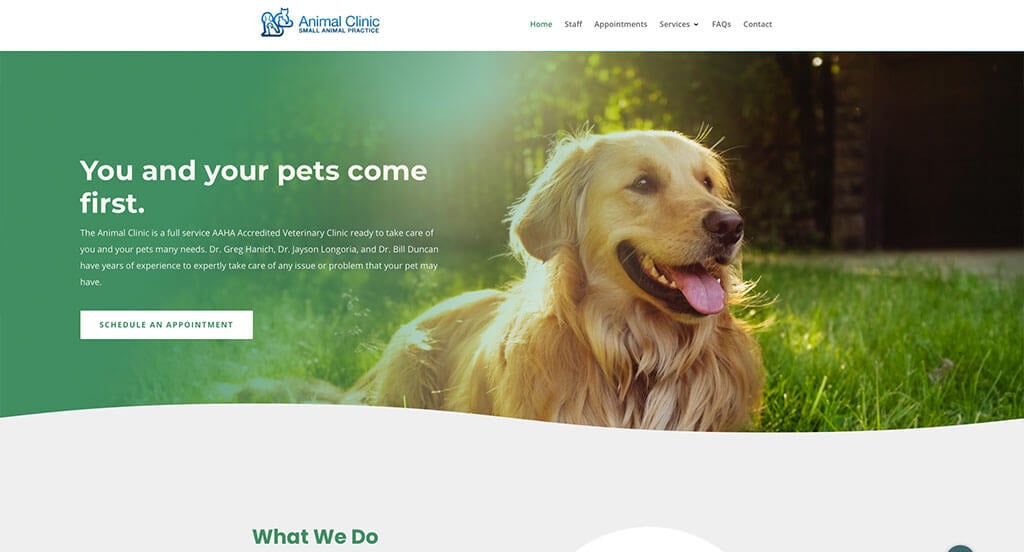
This is a good example of a veterinarian website design for looking for inspiration on a professional looking website. The wavy color blocks were was definitely the most impactful quality in the homepage of this website. This creative veterinarian website also does a good job with their color palette. Animal Clinic clearly had website usability in mind when designing the geometric graphics for their website. Give some thought to the unique design of this veterinarian website when developing your next custom website.
44. All West Veterinary Hospital
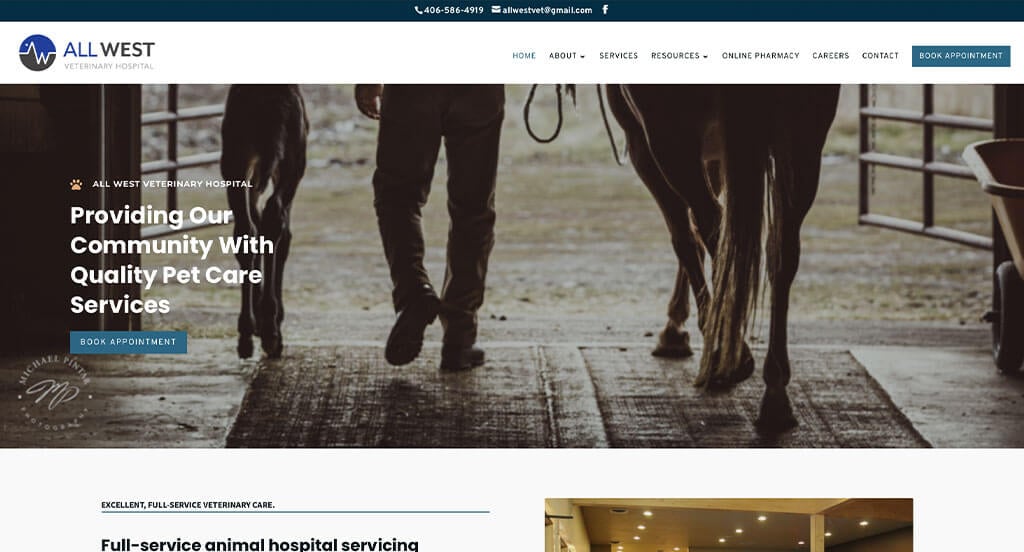
This is a good example of a website design for veterinarians who are looking for a custom site design. After scrolling past the header of this veterinarian website, you’ll immediately notice the accented blue color. The use of buttons throughout their site was a nice touch for a professional site. They clearly had a focus on website marketing when building the simple contact information for their website. Don’t skip past this website when hunting for design ideas for your next veterinarian website!
45. Arkansas Veterinary Clinic
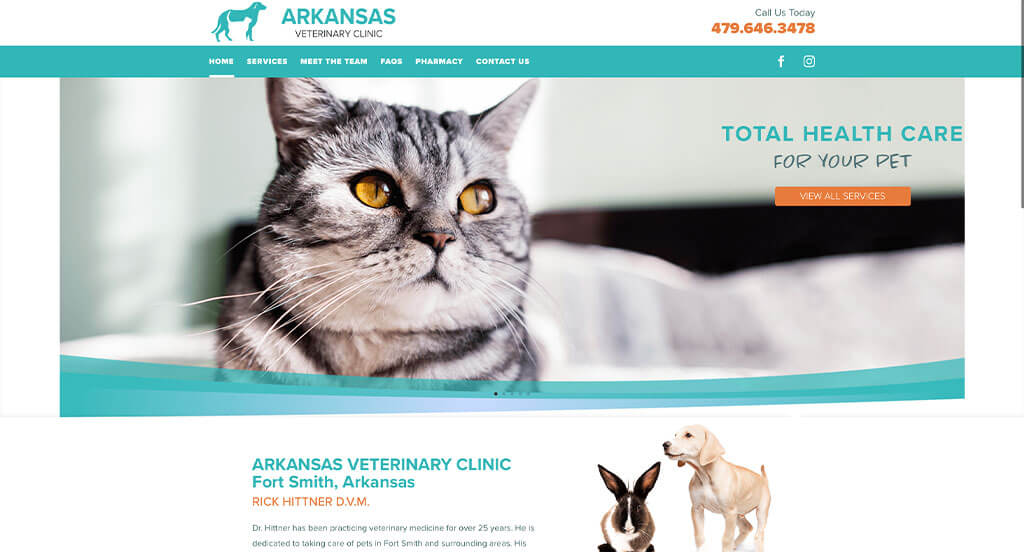
This is a great website design idea for a veterinarian who is looking for a custom look and feel for their next web design template. The inventive logo design was probably the most impactful feature in the homepage of Arkansas Veterinary Clinic. Another thoughtful feature in this professional veterinarian site was the warm hues use for their color palette. Arkansas Veterinary Clinic clearly had a focus on internet marketing when designing the layout that was free of distractions. What a great website to review when building out your next website!
46. Chenal Valley Animal Hospital
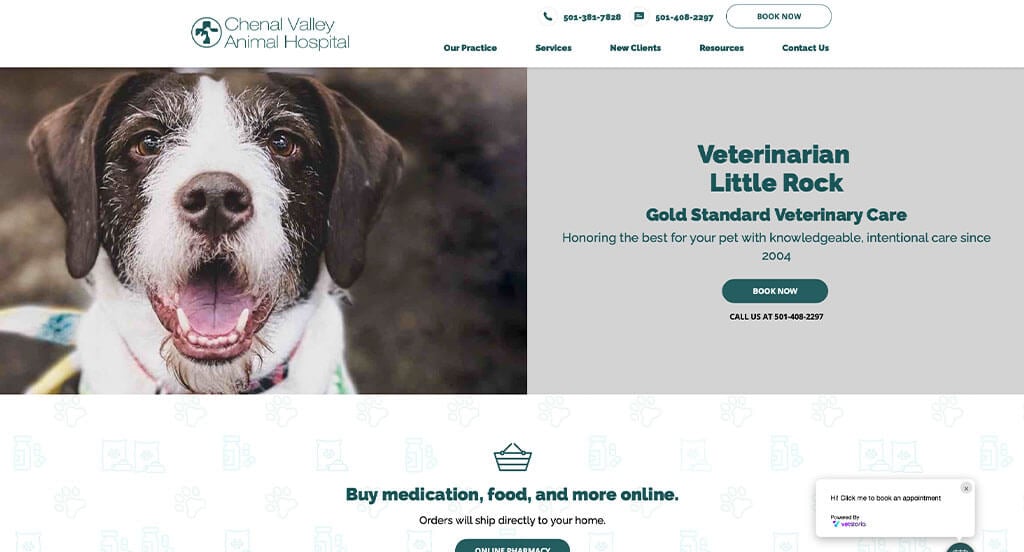
This is a great example for veterinarians who are looking for a professional look and feel for their next website. The part of this website’s homepage that caught our attention was definitely their use of different graphics. This clean veterinarian website also does a good job with their clearly labeled menu. They had website marketing in mind when building the bold titles for their website. If you are looking for template options for your next veterinarian site, give some thought to this one.
47. Lowell Veterinary Center
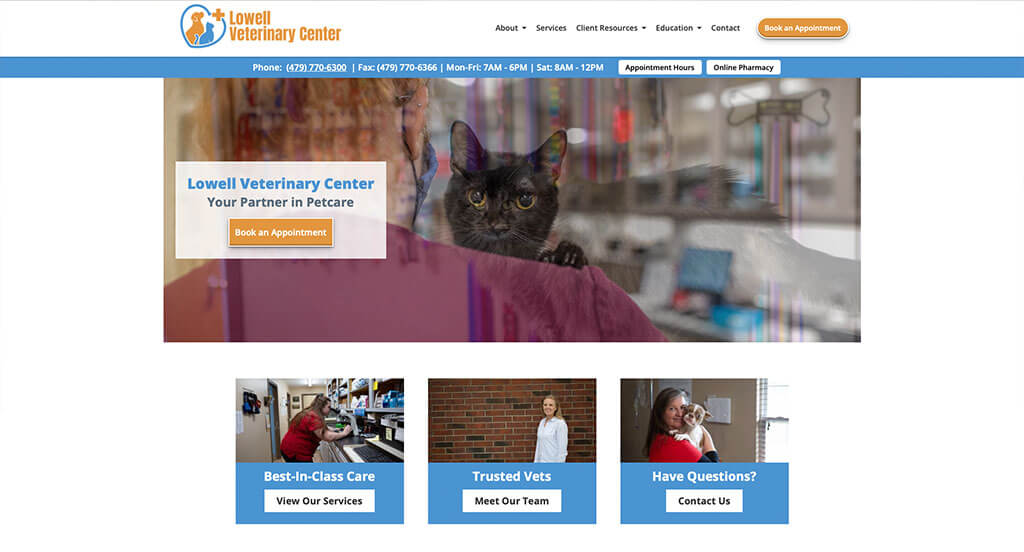
The website of Lowell Veterinary Clinic ranked because it’s one of the nicer veterinarian websites we have encountered. The look and feel of the homepage of this veterinarian website caught our attention because of their stunning color scheme. The customer review section in this website helped it make it into our list of the best websites templates for veterinarians. Lowell Veterinary Clinic clearly had digital marketing in mind when designing the simple navigation for their website. Don’t forget to check this website out while looking through our list of the best veterinarian sites!
48. Britton Road Veterinary Clinic
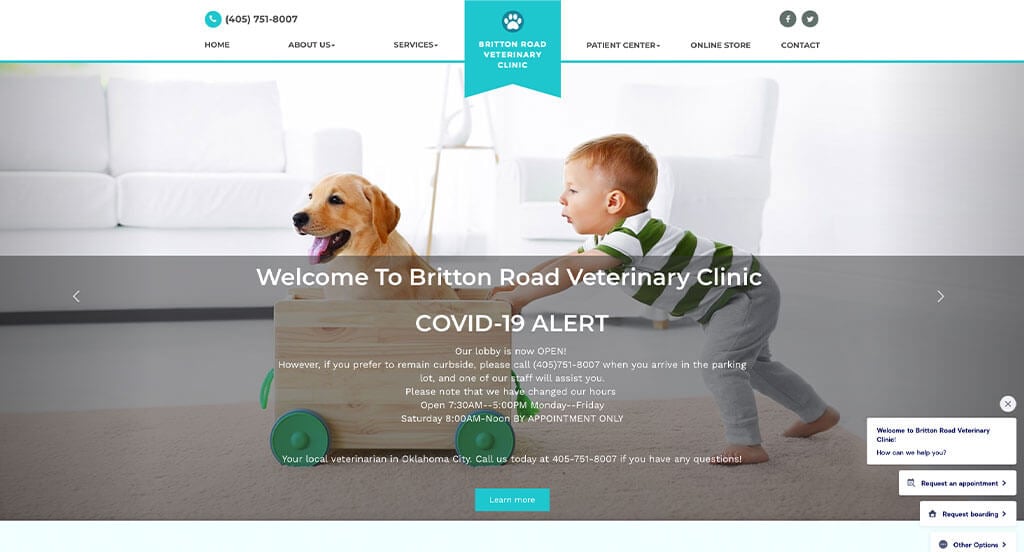
This is a good example of a veterinarian website design to see when looking for inspiration for a professional looking website. The look and feel of the homepage of this veterinarian website caught our attention because their layout that was easy to follow. The simple contact information was another reason why we included this website in our list of the best layout ideas for veterinarians. Britton Road Veterinary Clinic clearly had a focus on conversions when choosing the color scheme for their website. Another amazing website to add to this list!
49. Green Briar Animal Hospital
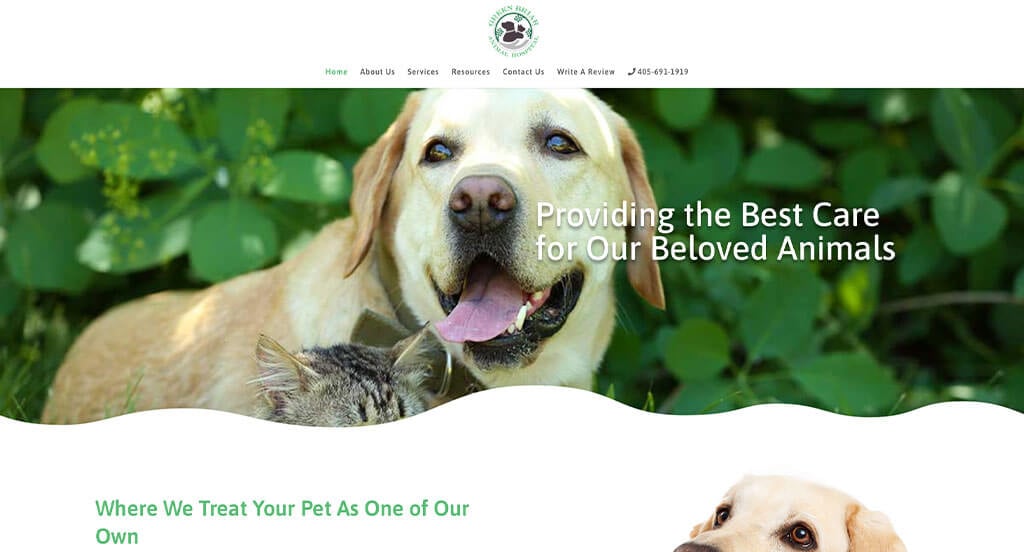
This is a great veterinarian web design example for someone who is looking for a professional layout. While most veterinarian websites share this quality, we thought Green Briar Animal Hospital did a nice job of with their relaxing color palette. This custom veterinarian site also does a good job with their simple contact information. Green Briar Animal Hospital clearly had a focus on website accessibility when building the domain for their website that matches the company’s name. Give some thought to the one-of-a-kind design of this veterinarian website when developing your next website.
How to Build a Great Veterinary Clinic Website
Are you in the process of building a new website for your veterinary clinic? How exciting!
Let’s walk through some of the most important steps in building a new, or redesigning an existing, veterinary clinic website.
Feel free to skip the first few sections if you already have a domain name, hosting service, and website platform picked out!
1.) Purchasing a Domain Name
Picking out a domain name for your veterinary clinic website is a crucial step in establishing your clinic’s online identity. It serves as the address that visitors will use to access your website, and it plays a significant role in branding and recognition of your clinic.
Here’s a step-by-step process to help you choose the perfect domain name:
- Brainstorm: Start by thinking of ideas for your domain name, considering the name of your clinic, the services you offer, and your location.
- Simplicity: Try to keep your domain name simple, easy to spell, and pronounce. Avoid using complex words, hyphens, or numbers.
- Consistency: If your clinic has an established brand name, it’s generally a good idea to include it in your domain name. For example, if your clinic’s name is Happy Paws Veterinary Clinic, don’t register a domain name such as 920LocalPetHealth.online.
- Availability: Check the availability of your desired domain names before proceeding further. Many common domain names may have already been purchased. If that’s the case, check if your desired domain name is available for sale. However, avoid investing excessive money in buying a domain name that’s for sale.
- Domain Extensions: Consider which domain name extension best suits your website’s purpose. While .com is the most common and widely recognized extension, there are many other options available, such as .net, .org, or industry-specific extensions like .vet.
- Legal Considerations: Before registering your domain name, it’s important to conduct a trademark search to ensure that your chosen name doesn’t infringe upon someone else’s intellectual property. For example, avoid registering a domain name that includes another veterinary clinic’s business name or the name of a popular pet medication company.
- Register the Domain: Once you’ve settled on an available domain name, it’s time to register it through a reputable domain registrar. We’ve found GoDaddy and Namecheap to be the easiest to manage domain name registrations.
2.) Choosing a Website Platform
After figuring out your domain name, the next step is selecting a website platform for your veterinary website.
Most veterinarians are going to develop content-based websites with contact forms, live chats, appointment calendars, and phone numbers to drive conversions.
WordPress is a suitable platform for most of these website needs. However, there are also options like Wix and other hosted website builders to consider.
- WordPress: WordPress is a versatile and widely used content management system (CMS) that offers tremendous flexibility and customization options. It caters to all types of veterinary clinic websites, from simple websites to more complex sites with integrated appointment booking systems. With a wide range of veterinary-inspired themes and useful plugins available, WordPress allows you to create a highly customized website tailored to your clinic’s needs. It’s a great choice if you value control and want the ability to expand your website’s functionality over time. Although there is a hosted version of WordPress, most people who use WordPress have the open-source version installed on a web hosting account.
- Wix: The Wix platform offers comparable page building features, but as a hosted solution. We have experience with veterinary clinic websites built on Wix, and it is an effective page builder. With Wix, you won’t need a separate web hosting service.
It isn’t incredibly common for veterinarians to launch ecommerce websites. That starts going down the road of pet food, toys, and pharmaceuticals which is an industry largely dominated by Petco, PetSmart, Amazon, and Chewy.
Web Hosting Requirements
If you choose a platform like WordPress or WooCommerce, you’ll need to find a web hosting service.
As a suggestion, we often recommend our own web hosting service, which is excellent for WordPress websites. If you prefer recommendations from other hosting companies, consider the following:
- WP Engine: This is one of our favorite web hosting services for veterinary clinics. WP Engine offers a great control panel that simplifies the creation of staging websites. Their backup process is seamless. The only downside we’ve encountered is the limits they place on PHP max_execution_time. However, their pricing can increase quickly if you require upgraded services.
- SiteGround: We have always enjoyed working with SiteGround. Their live chat and email support are excellent compared to more well-known hosting firms. We have never had to wait long to get in touch with someone, and the first person we’ve interacted with typically resolves the issue. Their backup tools are user-friendly, and they offer reasonable pricing for veterinary clinics.
- Digital Ocean: This is a great option for cloud hosting, although it may be too advanced for most veterinary clinic websites. We have never encountered issues with the Digital Ocean cloud network, unlike other cloud networks we’ve tried. However, cloud hosting can be an expensive option when considering droplet (server instance) costs, operating system, control panel, server software, offsite backup, and server management fees. If you need a server administrator recommendation, check out AdminGeekZ.
3.) Selecting a Website Template
Many veterinary clinics opt to purchase and customize a pre-made website template, as it significantly reduces web development costs and turnaround time. However, if your veterinary clinic prefers a custom design from scratch, you can always hire a custom web developer or custom ecommerce developer to build your theme according to your specifications.
For the purpose of setting up a veterinary clinic website, let’s focus on suggestions for finding a pre-built website template! Here are some links to the main theme marketplaces you can explore:
WordPress Veterinary Themes
You can find free themes at wordpress.org, or consider veterinary-inspired templates on ThemeForest.
PawFriends – Themeforest
$79
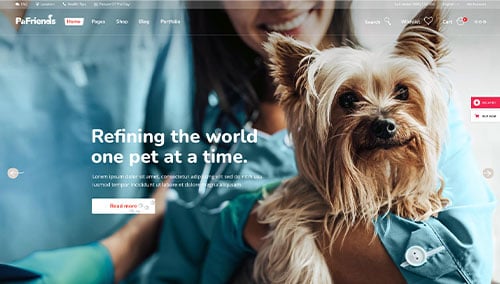
PawsCare – Themeforest
$69
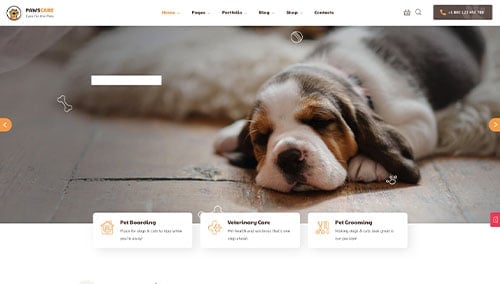
Petz – Themeforest
$59
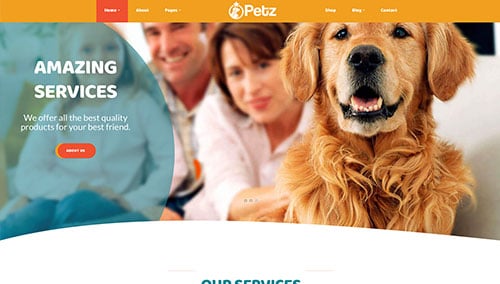
VetBox – Themeforest
$59
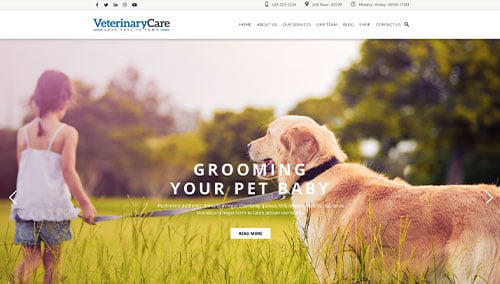
WooCommerce Veterinary Themes
You’ll find a variety of ecommerce veterinary themes for WooCommerce on ThemeForest.
Jinx – Themeforest
$59
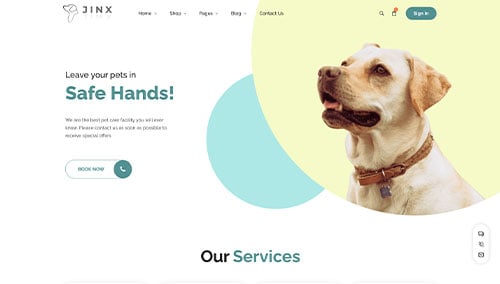
PetPuzzy – Themeforest
$58
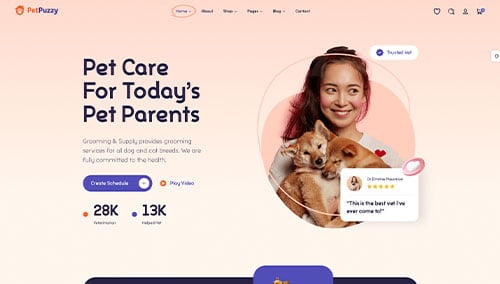
Shopify Veterinary Themes
You can find both free and paid themes at themes.shopify.com, or explore options through marketplaces like ThemeForest.
LuckyDogs – Themeforest
$39
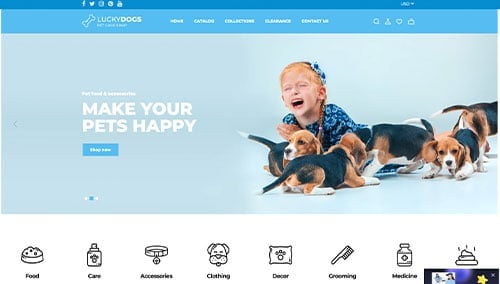
Furrie – Themeforest
$59
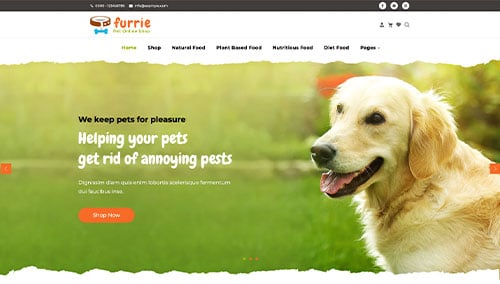
Wix Veterinary Themes
You can find both free and paid themes in the marketplace at wix.com, some of which are suitable for veterinary clinics.
4.) Creating Content & Adding Images
Now that you have your domain name, website platform, and theme in place, it’s time to start developing content for your veterinary clinic’s website!
Here are some valuable tips to help you craft engaging and effective website copy:
- Understand your target audience: Before writing, gain a clear understanding of your target audience. Define their demographics, preferences, and needs. Tailor your content to address their concerns, provide valuable information, and resonate with them. This will help improve your search engine rankings for veterinary-related searches relevant to your clinic.
- Define your key messages: Determine the main messages you want to convey through your website content. These messages should align with your brand, highlight your unique advantages, and clearly communicate the benefits of your veterinary services.
- Keep it concise and scannable: Online readers tend to scan content, so ensure your writing is concise and easy to digest. Use short paragraphs, bullet points, subheadings, and bold text to break up the content and enhance readability.
- Create clear and compelling headlines: Craft attention-grabbing headlines that immediately convey the value and relevance of your veterinary clinic. A well-crafted headline can entice visitors to explore your website further and learn more about your services.
- Incorporate keywords strategically: Conduct research on relevant keywords and incorporate them naturally throughout your content. This can improve the visibility of your veterinary website in search engine results. Avoid keyword stuffing, as it can negatively impact readability and user experience. Tools like Ahrefs or Semrush can assist with keyword research.
- Maintain a conversational tone: Write in a conversational style that resonates with your veterinary audience. Avoid jargon or overly technical language unless it’s necessary for your target audience. Engage your readers by addressing them directly and adopting a friendly, approachable tone.
- Edit and proofread: Always edit and proofread your veterinary content before publishing. Check for grammar, spelling, and punctuation errors. Ensure the flow of your content is smooth and logical, and that it aligns with your brand’s voice and style guidelines. Tools like Grammarly can be helpful in this process!
- Leverage ChatGPT for assistance: If you need help generating ideas or refining the content on your veterinary website, consider leveraging AI tools like ChatGPT.
In addition to well-written content, incorporating relevant and high-quality images into your website is important. Consider the following tips:
- Choose high-quality images: Opt for visually appealing and well-composed high-resolution images. Blurry or pixelated images can detract from the overall quality of your veterinary clinic’s website.
- Ensure relevance: Select images that are relevant to your content and help illustrate your message. The images you choose should enhance the text and provide additional context or visual interest for your veterinary clinic.
- Explore stock photo resources: Utilize reputable stock photo websites like Unsplash, Pixabay, or Shutterstock to find a wide range of professional-quality veterinary-related images that align with your theme. Ensure you comply with licensing requirements and attribute images as necessary.
- Customize images when possible: If you have the resources or skills, consider customizing or branding images to match your veterinary clinic’s brand. This can create a cohesive visual experience for your visitors. Tools like Adobe Photoshop or Canva can assist with image customization.
- Optimize image file sizes: Compress images to optimize their file sizes without compromising quality. Large image files can slow down your veterinary clinic’s website, affecting user experience and SEO. Tools like TinyPNG can help with image compression.
5.) Post Launch Tasks
After building and launching your veterinary clinic’s website, there are several important tasks and services to consider in order to maximize its effectiveness. Here are some essential suggestions to help you navigate post-launch activities:
- Search Engine Optimization (SEO): Implementing SEO strategies is vital to improving the visibility of your veterinary clinic in local search results. Conduct keyword research, optimize your content, and ensure your website has a solid internal linking structure. Regularly update and create fresh, high-quality content to attract organic traffic. Consider hiring our SEO team or third-party providers like The HOTH for assistance.
- Paid Advertising: For quicker traffic results, consider utilizing paid advertising platforms such as Google Ads or Facebook Ads to drive targeted traffic to your veterinary clinic. You can hire our PPC management services or find talented professionals on websites like Mayple.
- Conversion Rate Optimization (CRO): Analyze your veterinary website’s performance and user behavior using tools like Google Analytics. Identify areas where users may drop off or encounter barriers to conversion. Conduct A/B testing with tools like VWO to make data-driven changes that enhance your veterinary website’s conversion rates and overall user experience.
- Website Security: Protecting your veterinary website from malware and other threats is crucial. Ensure you have robust security measures in place, such as SSL certificates, web application firewalls (like Sucuri), and regular backups. Keep your CMS, plugins, and themes up to date to minimize vulnerabilities. Monitor your website for potential security risks and respond promptly to any issues. It’s also beneficial to monitor website uptime using a service like UptimeRobot.
- Website Maintenance: Regularly maintain your veterinary website to ensure optimal performance. If you’re using WordPress, this includes updating plugins and themes, monitoring website speed and performance, and resolving any broken links or errors. Consider hiring our website maintenance services or finding a freelancer on Upwork. Don’t forget to regularly back up your veterinary website to protect against data loss or technical issues.
- User Feedback and Testing: Actively seek user feedback to understand visitor experiences and identify areas for improvement. Implement user testing and gather insights on how users interact with your veterinary website. Use this feedback to make iterative enhancements and continuously optimize the user experience.
- Content Updates: Keep your website content fresh and up to date. Regularly publish new blog posts about veterinary topics, update information about your services or products, and ensure that all information is accurate and relevant. Engaging and valuable content not only attracts visitors but also encourages them to return and share your content with others interested in veterinary care.
Remember, post-launch digital marketing activities are crucial for the long-term success of your veterinary website. Stay proactive, monitor performance, and adapt your strategies to achieve your business goals and meet the needs of your audience.